#shinbutsu
Explore tagged Tumblr posts
Text
Please join this server dedicated to Japanese Buddhism! ☸️🙇🏻
1 note
·
View note
Text
Imakumano Kannon-ji




The story goes that Kūkai was in the area and a bright light came upon him, and revealed itself to be Kumano Gongen (kami of the Kumano Pilgrimage). He gave Kūkai a statue of the 11 Faced Kannon that had been carved by Amaterasu Ōmikami and instructed him to build a temple, alongside that statue Kūkai carved a second one and enshrined them together.
I love how many of Kūkai's tales really reflect the importance of Shinbutsu Shugo during his time and his respect for and reverence for the kami. It's neat.



There was of course a shrine dedicated to Kumano Gongen on the grounds.
And of course here's the goshuin

#Imakumano Kannon Ji#Imakumano Kannon-ji#buddhism#shinbutsu shugo#kami#photos#goshuin#Temples#Shrines#Shinto
7 notes
·
View notes
Text
I'm considering starting a series on my Wordpress where I give information on kamisama - head shrines, known unique offerings they like, and so on. I am also a minimum wage worker, so I may make this a Patreon thing where people can vote for the next kamisama I write about. IDK. Thoughts? Please feel free to reply or what have you.
(For clarity, the information would be public, but being a Patron would simply give you the ability to request kamisama or vote)
10 notes
·
View notes
Text
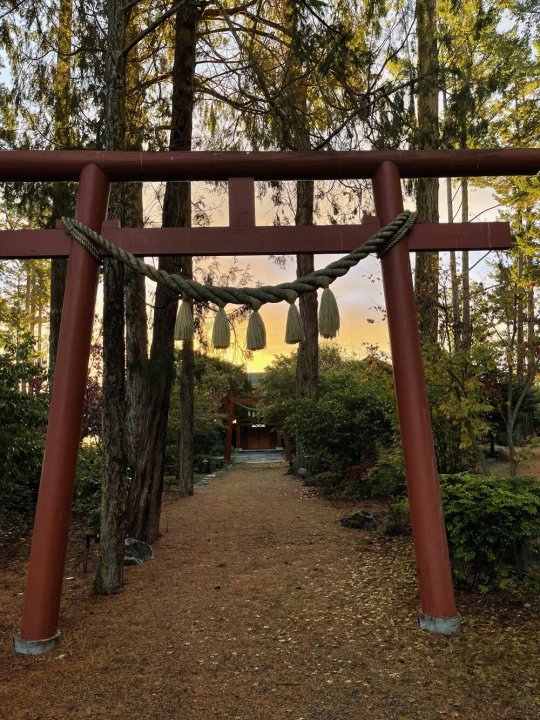
9 notes
·
View notes
Text
In my studies I've seen many pictures of small shrines like this. Because Buddhist and Shinto so often look very similar it's becomes necessary to look for visual clues to determine if it is a Shinto shrine, a Buddhist shrine, or some curious mix of the two.
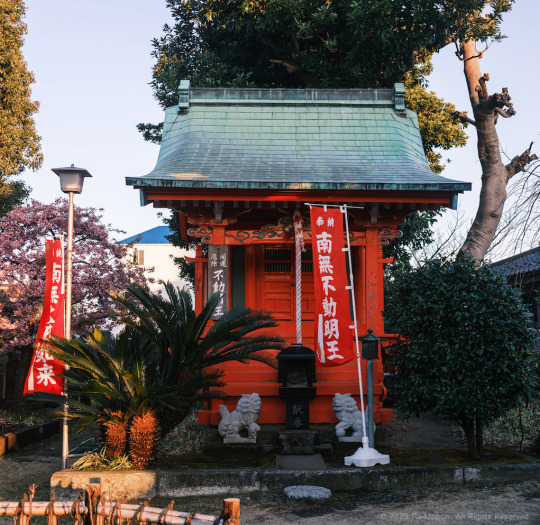
A Small Vermilion Shrine for Fudōmyō-Ō, the Immovable Wisdom King ・華寺境内の朱色が美しい不動明王堂
A small vermilion shrine housing a statue of the Buddhist deity Fudōmyō-Ō, or the “Immovable Wisdom King.”
Although located within the grounds of Ryuge-ji, a Buddhist temple, the shrine’s architecture closely resembles that of a traditional Shinto hokora. It’s a quiet example of how Japan’s two spiritual traditions — Buddhism, introduced from China, and indigenous Shinto — once blended naturally in daily life.
This fusion is known as shinbutsu-shūgō (神仏習合), the harmonious coexistence of kami and Buddhas that flourished for centuries. While the Meiji government’s separation order in 1868 sought to divide the two, the effort was not entirely successful. Even today, small moments like this remind us of the enduring ties between them.
Location: Kanazawa Ward, Yokohama, Japan Timestamp: 2025/01/09 17:12 Fujifilm X100V with 5% diffusion filter ISO 320 for 1/480 sec. at ƒ/2.5 Classic Negative film simulation
For a deeper dive, check out sources for further reading and Google Maps links: https://www.pix4japan.com/blog/20250309-fudomyo-o
23 notes
·
View notes
Text
Sukuna's Backstory Theory (+ mini Uraume Backstory Theory)
While we wait for jjk ch 265 leaks, I hope you enjoy reading this post of mine in the meantime.
Please note that this is just my theory. Also, Sukuna deserves to die.
Now enjoy your reading.
WARNING: MANGA SPOILERS UP TO CH 264; subject covers the following sensitive topics: sacred s*x, cannibalism, homosexual relationships; mentions or implications of abuse

Beginning:
We know from Sukuna himself in chapter 237 that he was an 忌み子 - a taboo child. In ancient and medieval Japan, a taboo child is a child that is ostracized, unwanted, and discarded.
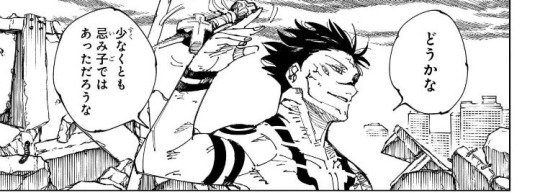
JJK CHAPTER 237
As mentioned by Sukuna, he himself 'consumed' his twin to survive and had presumed that his 'foolish mother' (愚母 - he wasn't looking down on her, calling her stupid, but instead he was humbly referring to her) must have been starving.
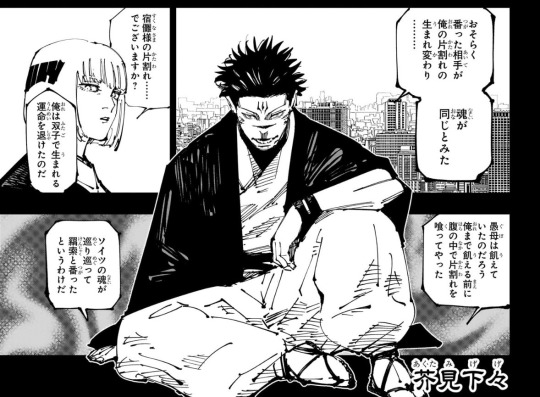
JJK CHAPTER 257
Prominent families during that time were the Fujiwara, Sugawara and Abe clans. For sure, he wasn't born a noble, but rather a commoner, or worst, a slave. He must've been born with weak or below average CE, too, aside from his four arms, four eyes, and the second face.
It was probably only him and his mother in the beginning and she was the only one taking care of him. Given their supposed circumstances, Sukuna must've started working by the time he was around 5 or 6. Plus, if I were to guess where they would've lived, it would be in the agricultural lands of a Buddhist-Shinto temple. In Heian era, Buddhism and Shinto co-existed together (shinbutsu-shuugoo) so it's not strange to find Buddhist temples to have at least one small shrine dedicated to a kami (a Shinto god/goddess) [these are calles jisha (寺社)] and Shinto shrines accompanied by Buddhist temples in mixed complexes [these are called jinguuji (神宮寺)].
In addition, these institutions had these manorial estates called, shooen (荘園), which were "any of the private, tax free, often autonomous estates or manors...... developed from land tracts assigned to officially sanctioned Shintō shrines or Buddhist temples or granted by the emperor as gifts to the Imperial family, friends, or officials." In the case of shrines and temples with shrines in them, they are called mikuri (御厨), which means a god's/goddess' kitchen.
The Chinese characters for mikuri are the same as the first two letters of Sukuna's CT (御厨子). In the beginning, mikuri only referred to the place where shrine offerings/sacred food (fish, vegetables, etc.) were cooked, but it eventually also included the land or property where they get the offerings from and prepare them in the meaning. Plus, the citizens of these lands/properties were called "gods' & goddesses' people" (神人, shinjin), and these mostly consisted of the producers (fishermen, farmers, etc.). We can definitely infer that Sukuna has most likely worked in the cooking area of the mikuri, the 御厨子所 (mizushidokoro, a kitchen for the upper classes and the shrines and temples) Think about it, not only does he use words related to consuming, but he also referenced fish-related words.

JJK CH 224 - "A fish who merely has no name attached to it."
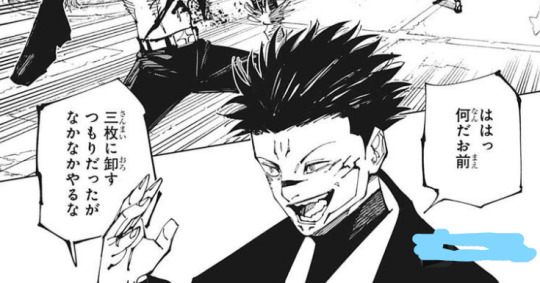
JJK CH 216 - "卸す" - to grate (e.g. vegetables); to cut up fish "三枚に卸す” - to cut you into three slices (fillet)
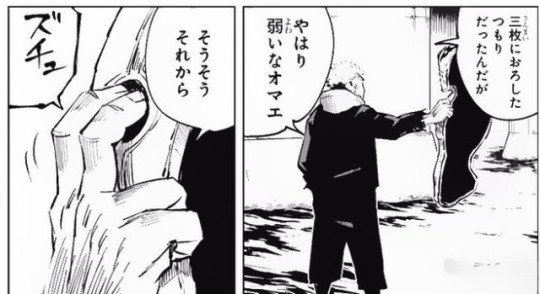
JJK CHAPTER 8 - "おろした" - past tense verb of 卸す "三枚におろした” - cut you into three slices (fillet)
(light blue is just to cover watermarks)
In Heian era, meat was forbidden except for some parts in Japan where hunting was really common (except for aristocrats and monks lowkey - they do eat them at times, especially when they fall sick). Fish was temporarily banned but was eventually lifted. So, majority of the Japanese people during this time period didn't eat meat with the exception of fish and other seafood. Moreover, when cooking the shrine offerings, the only meat they cooked was seafood. Plus, if he and his mom was in one of the shrine and temples in Heian-kyoo (present-day Kyoto), then chances are he had to cook for festivities and rituals in the imperial palace.
But then, how did he learn to read and write? The only one who were literate were the imperial family, aristocrats, Shinto priests, Buddhist monks, and anyone else related to religious institutions and higher rank than commoners. So the only available ways for him to have access to learning kanji (漢字 - Sino-Japanese characters) and even kana (hiragana and katakana) was to become an apprentice monk or priest. But I believe he became a Buddhist apprentice monk since it is more open than becoming a Shinto priest.
If he had started as a worker in the mikuri, he would have been secretly listening to the lessons between an apprentice and the older monk. Then, if he managed to prove his talent, he could have become an apprentice. If he were an apprentice monk, he would have to learn directly from an older monk. This would not stop him from working as a kitchen worker since he would have to help with preparing offerings and cooking for important occasions and guests.
As an apprentice, he would have learned everything about Buddhism, including how to preach to people. Unfortunately, there was a cost to this. It was the nanshuudou, the homosexual practice between a prepubescent apprentice monk and an older adult monk, which is heavily documented in Edo period but a practice that has been ongoing in the Shinto priest apprenticeships and eventually in Buddhist monk apprenticeship, as well. Mind you, this is not a practice between male lovers, but of loyalty and the first step to 'reaching enlightenment'. I think of it as a pseudo-sacred s*xual relationship. It is something expected at that time, but it may not have been a great experience for Sukuna. He was a taboo child, meaning even those older monks most likely made this harsher than it already was. Not to mention, he might have been as young as 7 or 8 years old when this all happened.
This was also sort of thought of by a JP theorist, according to this twitter user.
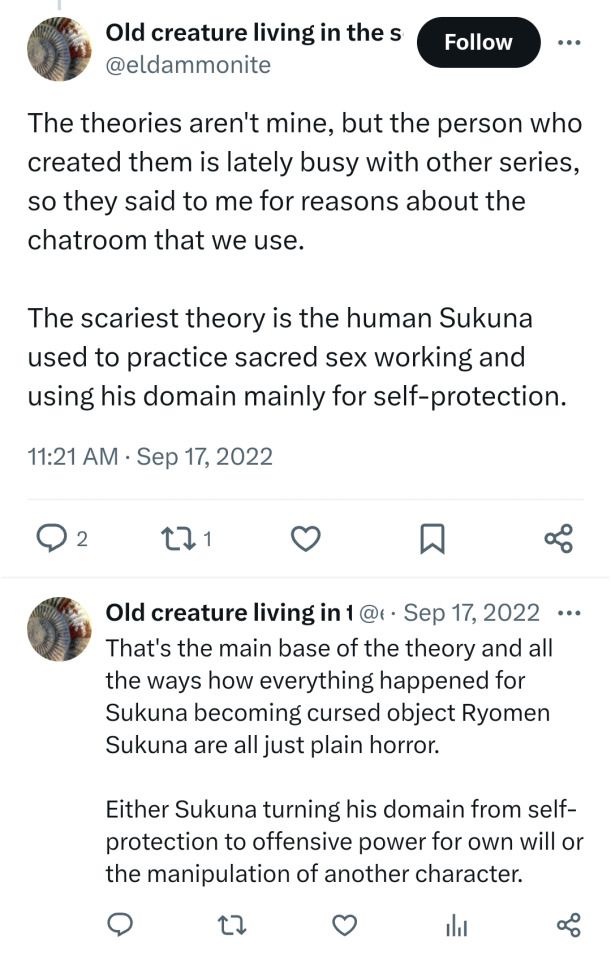
Anyways, let's move on from this sensitive topic.
You might be wondering why do I think he had been an apprentice monk and a cook? Well, mizushi (御厨子) also has these meanings.
Zushi (厨子) originally was a word for storage boxes for utensils and ingredients in the kitchen, then extended into becoming a storage for personal stuff and a decoration as well for aristocrats.
Zushi also extended to becoming a storage for Buddhism relics, scrolls or anything important. This includes the Buddhist altars. Thus becoming Mizushi, sacred storage.
Additionally, as an apprentice monk, he would be able to interact with nobility more. Buddhism was intertwined with the court politics in Heian era. This is more prominent when court officials and even the imperial family members, including the Emperor, would retire as Buddhist nuns or monks. Plus, there would also be visits by the officials and probably he was able to see or receive letters and poems from them. It would be inevitable that he learns them to communicate effectively.
This would also makes sense as he knew Tengen, who was an avid supporter of Buddhism.
Career as a Sorcerer:
In an era where the Fujiwara clan ruled supreme, leaving barely any crumbs for other aristocratic clans to take spots in the political arena. So, in order to consolidate their own power, many other clans (including the minor/weak branch families of the Fujiwaras) and Imperial princes went to obtain their own land outside of Heian-kyoo (present-day Kyoto) and even their own army. That's why these clans have armies of their own, especially those full of sorcerers. I won't be surprised if they took in anyone who has curse energy and trained them, just like what the Fujiwaras did with Uro.
So, I believe that someone noticed his cursed energy and his potential, then took him for training. Then obviously he would have met other Heian-era sorcerers. Here are my two cents on this:
I would like to believe that Tengen trained him as she was also an avid supporter of the religion, and he eventually met Kenjaku as they're 'friends' with her. Being a jujutsu sorcerer apprentice meant quitting or being part-time in his apprenticeship from the Buddhist Temple. (But I wonder if this would have stopped the pseudo-sacred s*x stuff.......) However, I'm open to the fact that it might have been another sorcerer who trained him (or there has been another one besides Tengen and Kenjaku who did so or influenced him) due to the name of his extension technique 'Divine Flames, Open'
One of the opposing factions (either the Sugawara, Tachibana or Abe clan) to the Fujiwara hired him in their order to put them in check. I'm leaning more towards the Sugawara clan.
This was probably the time when he probably met Angel from Abe clan, Uro from the Fujiwara, and especially Uraume. I'll explain how Uraume is related to the Sugawaras in a bit.
Sukuna served as part of Sugawara's troops or something like that. This can also be the point where he learned more about Japanese art and culture at the time.
One of the curses he must've fought was Yamata no Orochi.
Sukuna betrayed the Sugawaras and destroyed its army of sorcerers, with a few survivors left. Uraume decided to dedicate their whole life to him and followed him from then on.
He officially became a curse user and wrecked havoc in Japan, especially Heian-kyoo
Angel got enraged from his acts and with the permission of the Abe clan and the remnants of Sugawara clan, they jumped on Sukuna but lost.
Later on, he defeated the Fujiwara army led by Uro.
How is Uraume related to the Sugawaras?
There's this video from JP channel that was theorizing about Uraume when they first appeared in Shibuya arc a couple years ago that they used to be trapped in the prison realm before being freed so that Kenjaku can use it for Gojo Satoru and it was time for Sukuna's resurrection but this was obviously debunked, but there was something interesting that the creator brought up - the Tobiume.
Have you heard about The Legend of the Flying Plum (飛梅伝説)? So basically, when Sugawara no Michizane was demoted in ranking because of the Fujiwaras and was exiled, he wrote a poem expressing his sorrow of not seeing his precious plum tree in his residence in Heian-kyo (present-day Kyoto) ever again. Then from this, a romantic legend came about, where the plum tree was so fond of its master and cannot bear to be apart from him that it finally flew to Dazaifu, where he was exiled to, and that tree became known as tobi-ume (飛梅, 'the flying plum').
Michizane loves plum trees and plum blossoms, so it won't be strange if there were people in the clan named after plum blossoms or plum. In my case, I believe that Uraume is related to the Sugawara clan, but their status in the clan itself wasn't great. We can assume from their name in kanji, 裏梅.
裏 means the following:
opposite side; bottom; other side; side hidden from view; undersurface; reverse side
rear; back; behind
in the shadows; behind the scenes; offstage; behind (someone's) back
梅 means plum
Though they may have been born from a noble, prestigious clan, they remained in the shadows. My theory is that, for whatever reason it may be, Uraume's life wasn't as good as before Sukuna allowed them to serve him. They might have been an illegitimate child or they might have some deformity we don't know of, or whatever. Then they met Sukuna and the rest was history.
Do you not believe that Uraume is not related to the Sugawaras?
Let me show you a picture of the Sugawara clan crest.

They call this umebachi. A plum blossom crest.
And what's in Uraume's name? Ume (梅) - plum.
Another thing here that fulfill its name is the fact that Uraume is Sukuna's servant. Just like the tobiume, they follow their master from behind and cannot bear to be apart from him.
'Divine Flames, Open':
Here's something that caught my attention.
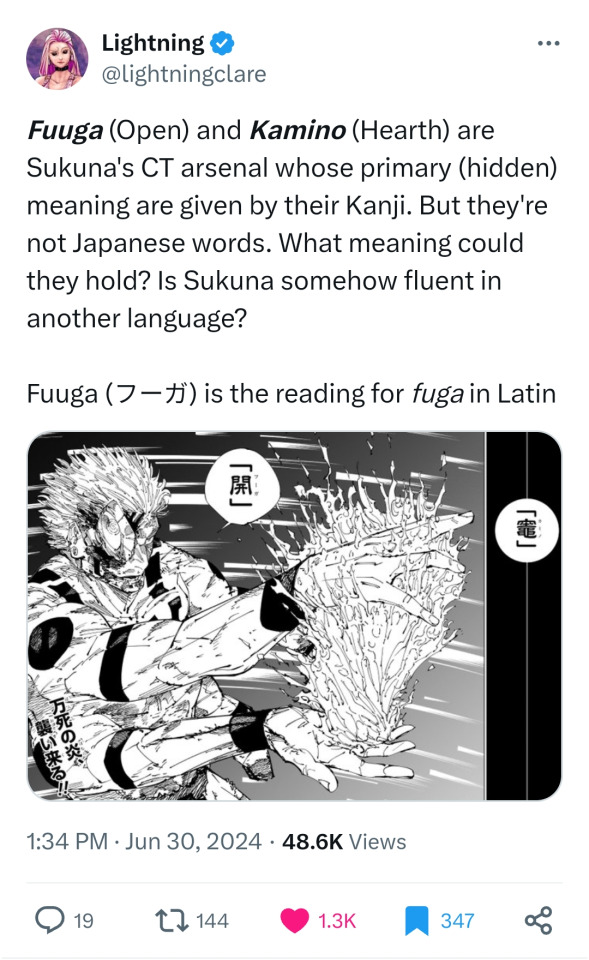
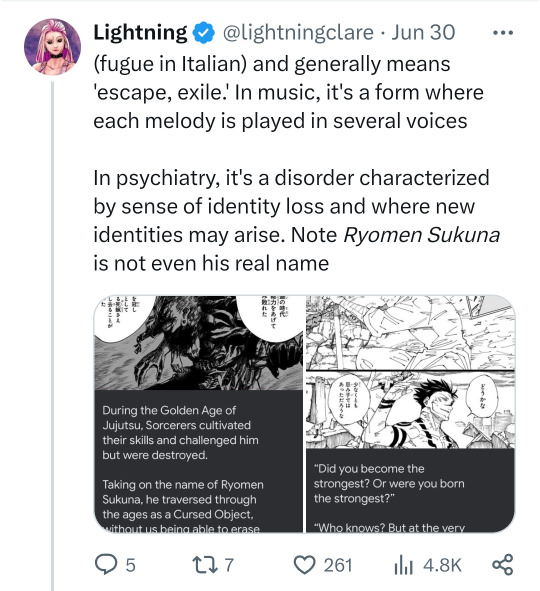
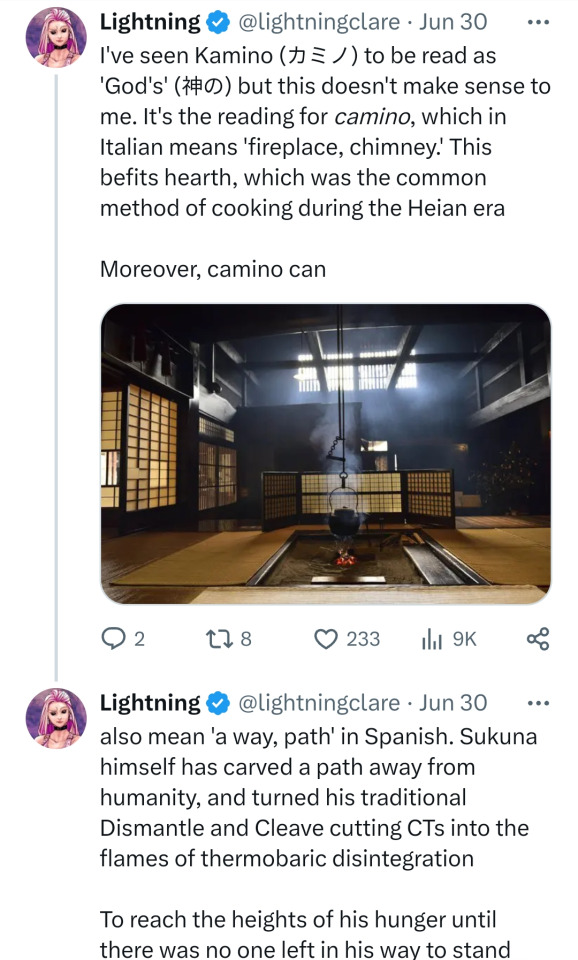
Kamino (カミノ) has the kanji 竈, that is originally pronounced as kamado. It means traditional Japanese wood or charcoal-fueled cook stove. Fuuga (フーガ) has the kanji 開, originally pronounced as kai, meaning open. Now everything else is purely Japanese except these two.
Kamino and fuuga originated from Latin and Ancient Greek, and both exist in the Romance languages. How tf is he using these words? Around Heian era, only the Eastern Roman Empire is standing and the main language there was Greek....... but that's around present-day Turkey and its surroundings. The furthest they reached in trade was China...... oh wait, Heian era Japan still traded with China........
Seems like that theory of Chinese sorcerer isn't far-fetched, eh?
(But fr tho, do you think he met someone from Byzantine? There's no confirmation time travel is a thing so that's the only possible explanation)
Cannibalism:
Cannibalism, believe it or not, was practiced in China from Tang Dynasty and onwards. Remarkably, Heian era's last major Chinese contact was with Tang Dynasty. Records of cannibalism must have been brought from Tang Dynasty China along with Buddhism and other things by monks who were sent to China by the government.
It was said that human flesh of a young person was a great medical treatment for illnesses. So there would be young people, especially females, sacrificing some of their flesh for the sake of their parents or parent-in-laws recovery. Furthermore, Emperors, e.g. Wuzong of Tang, supposedly ordered provincial officials to send them "the hearts and livers of fifteen-year-old boys and girls" when they had become seriously ill, hoping in vain this medicine would cure him. Later on, private individuals sometimes followed their example, paying soldiers who kidnapped preteen children for their kitchen.
There was also something called war cannibalism, in which victors in a battle, war, or conflict would eat the dead enemy's flesh as "official punishments and private vengeance", as well as "celebrating victory over them."
Therefore, I propose that Sukuna started cannibalism as a way to treat an illness or disease - in private obviously since in Heian era, meat other than seafood was banned and meat that becomes available for special occassions or circumstances like falling sick are reserved for the upper class, plus if he ever was an apprentice monk, he would not have been allowed to consume meat. Since Heian era had outbreaks, such as smallpox, and also common diseases, anyone can get it, including him. So, not wanting to die, he resorted to this. But then it eventually became a habit that also extended to eating people he defeated in battles and young people and women for medicinal and nutritional purposes later on. This is the most likely the reason why in the first chapter, he was looking for children and women.
But if he had contracted some sort of illness or disease at some point in his youth and cannibalism (obviously) wasn't a cure for it, how would he have survived it and lived longer? Perhaps it might have to do with Tengen - who knows if she could have an extension technique of her Immortality CE, where she could have extended his lifespan. It could have had to do with Kenjaku; with their vast knowledge, it's possible he offered a solution to him. However, I'm leaning more towards Tengen helping him in this regard. It was also probably the reason why she ended up having four eyes and all because of this. But, of course, he couldn't escape death, so he agreed to Kenjaku's terms and became cursed objects to reincarnate later on.
My second proposition is that Sukuna was maltreated and the people didn't bother sharing meager amount of food available to him. We know that because of the Fujiwara family's political monopoly in the capital as well as the distribution of the land to nobility made it possible for them to abuse their power. For instance, these lords imposed taxes in an unreasonable amount to fund their lavish lifestyle, which obviously made life hard for the peasants and slaves since goods such as silk, grains and food became a common medium of exchange when the currency fell. So you can imagine how much they had to give up just to pay their taxes. This definitely made their food supply low. I can also imagine Sukuna was blamed for misfortunes and misery they have experienced because of his status as a taboo child. I don't think they would provide him food and so he would have to rely on dead people to survive.
And assuming that we're going off with this proposition instead of the other one, I think the reason why Sukuna was seeking women and children because in the past, it was more common for children and women to die. Children are naturally more vulnerable and women die easily, especially during childbirth. I'm certain that the most common corpses or bodies he must've found were those of children and women. But, of course, eventually he began to crave humans because he got so used to it that normal food didn't satisfy his hunger any longer - not that cannibalism fully resolved it, though.
The Fallen:
(I'm not gonna lie, majority of what I would say here are more assumptions based on Geto's and a bit of Yuji's acts)
Everyone has been comparing Sukuna and Gojo, seeing them as foils and parallels. I acknowledge that they are similar to each other and whatnot. But what if I tell you that he could've gone through an experience or two similar to Geto?
Think about it. Wouldn't you consider Geto as a 'Fallen One'? He was a righteous man, whose goal is to protect the weak as a strong person. But after the Toji incident, his moral convictions and purpose has been questioned by himself, and eventually, he fell from grace - being stripped of his status as a jujutsu sorcerer and thus becoming a curse user. He had the same values but they were reinterpreted and twisted.
If my theory on Sukuna being educated at a Buddhist Temple is true, then he must have believed in the salvation of those who are suffering (like Yuji to some extent), but was corrupted along the way. He had the same ideals, but it became reinterpreted and twisted. I think the reason why he hates Yuji because he is seeing all those he threw away to gain freedom and absolute strength in jujutsu in him. Both of them are inverses of each other, and it's not a surprise if Yuji is the representation of the old Sukuna.
I mean if you look at nobility back in Heian era, they kept indulging themselves in leisure and pleasure to the point that they neglected the economy. Literally the currency fell and all those bureaucratic and admin work fell mostly to lower classes working in each ministry. Basically back then, the higher you were in the hierarchy, the more pleasure you could attain and keep chasing for. How else did you think Japanese art, literature and culture came to be during this era? This was where he probably learned about hedonism or what influenced him to be one.
Not to mention, people who would've taken advantage of him for their pleasure, curiosity, greed and personal gains, power and control, and many more reasons. He could have been like Geto and Yuji, who exorcise curses and help the weak. There was a turning point where he decided to let go of everything and walk the path that he has been in for the last 1000 years.
I am not surprised if he decided to be who he is today as a revenge to the world, a response to the trauma and suffering he went through just like Geto.
If I am right about Sukuna going through a similar experience as Geto did, then this page below brings a whole new meaning to the Gojo vs Sukuna fight on December 24, 2018 - the death anniversary of Geto:
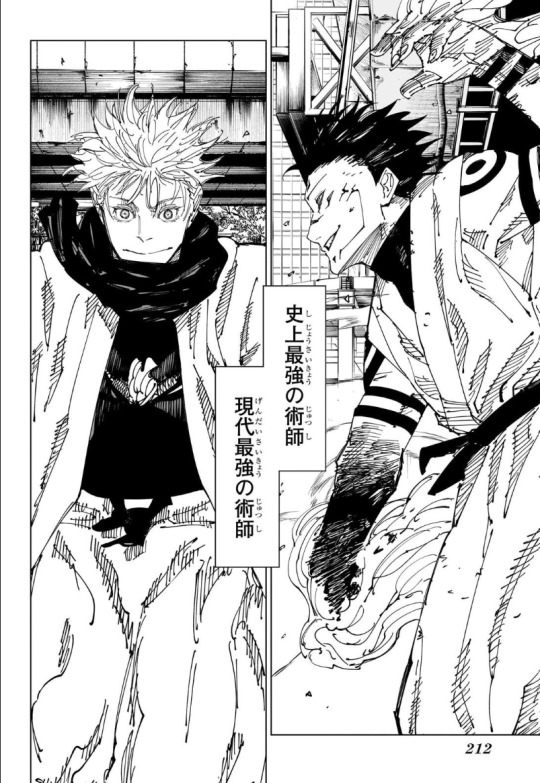
JJK CH 223
But despite all of these, there's one thing we can agree on - that is, he became the monster the world sees him as in the end.

That will be it. I hope y'all like it to some extent. Until then.

References:
Heian Era, Buddhism, 御厨子 -related Topics:
https://en.m.wikipedia.org/wiki/Sh%C5%8Den/
https://ja.m.wikipedia.org/wiki/%E5%BE%A1%E5%8E%A8
https://en.m.wikipedia.org/wiki/Buddhist_temples_in_Japan
https://www.britannica.com/place/Japan/The-Heian-period-794-1185
https://www.colorado.edu/ptea-curriculum/imaging-japanese-history-1
https://ja.m.wikipedia.org/wiki/%E5%8E%A8%E5%AD%90
https://en.m.wikipedia.org/wiki/Sugawara_no_Michizane
https://en.m.wikipedia.org/wiki/Heian_period
https://www.colorado.edu/ptea-curriculum/imaging-japanese-history-1
Homosexuality in Medieval Japan:
https://www.tofugu.com/japan/gay-samurai/
https://ida.mtholyoke.edu/items/19c86409-c129-46a1-927b-11cfe0ffb1c3
Cannibalism & Sacred S*x-related Topics:
https://en.m.wikipedia.org/wiki/Human_cannibalism
https://en.m.wikipedia.org/w/index.php?title=Medical_cannibalism&diffonly=true
https://en.m.wikipedia.org/wiki/Cannibalism_in_Asia
https://en.m.wikipedia.org/wiki/Sexual_ritual
https://en.m.wikipedia.org/wiki/Sacred_prostitution
Ancient Greek, Latin, & Roman Empire Topics:
https://en.m.wiktionary.org/wiki/fuga
https://en.m.wiktionary.org/wiki/caminus
https://en.m.wiktionary.org/wiki/camino
https://en.m.wikipedia.org/wiki/Sino-Roman_relations
YouTube Videos I Referenced:
https://youtu.be/5n24Ulc8u84?si=Nngbg4xEqyNu82x8
https://youtu.be/WhBN29CIuAQ?si=5bNryoT-GzleIGq9
Reddit Posts I Referenced:
https://www.reddit.com/r/Jujutsushi/comments/1bngk9x/i_solved_one_of_the_great_mysteries_of_the_heian/
https://www.reddit.com/r/AskHistorians/comments/ztay5e/what_foreign_countries_did_japan_have_trade/
https://www.reddit.com/r/AskHistorians/comments/zs4k9p/what_was_life_like_for_the_average_people_heian/
Twitter Posts I Referenced:
https://x.com/eldammonite/status/1571157320570380295
https://x.com/lightningclare/status/1807467771913269374
#jjk#jjk manga#jjk meta#jjk sukuna#sukuna#ryomen sukuna#sukuna ryomen#uraume#jjk uraume#jujutsu kaisen manga#jujutsu kaisen#jujutsu geto#jjk geto#gojo satoru#geto suguru#jjk spoilers#jujutsu sukuna#jjk 265
188 notes
·
View notes
Text
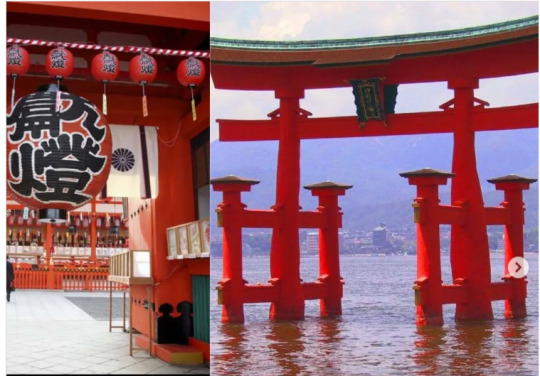
Sean bienvenidos, japonistasarqueológicos, a una nueva entrega de religión nipona, una vez dicho esto pónganse cómodos qué empezamos. - Seguramente, todos hemos escuchado hablar del Budismo y Sintoísmo, dos religiones muy diferentes entre sí, ya que sus pilares religiosos no están hechos de la misma materia, voy a intentar resumir este tema para que todos podamos entenderlo mejor. ¿Cuándo llego el budismo a Japón? Llego en el siglo VI d.c en el período kofun también denominado protohistoria, lo que no voy a negar y lo que todos sabemos es que china, India y otros países influenciaron a Japón y eso lo podemos ver todavía a día de hoy. - Pero hace poco vi el uso de la palabra Sincretismo religioso, lo cual, me parece el término de lo menos apropiado, ¿Qué significa sincretismo? Unión, fusión e hibridación, casos más claros, lo podemos ver en Latinoamérica y con Grecia y Roma. Por lo cual el término más apropiado para este caso sería coexistencia o convivencia, además en el periodo meiji hubo una reforma religiosa para separar ambas religiones y convivencia al sintoísmo, religión del estado, a esto se le llama Shinbutsu bunri en hiragana sería:(しんぶつぶんり) ¿Qué opinan ustedes? - Espero que os haya gustado y nos veamos en próximas publicaciones que pasen una buena semana. - ようこそ、考古学的日本びいきの皆さん、日本の宗教の新連載へ。 - 仏教と神道、この二つの宗教の柱は同じ材料でできているわけではないので、私たちは皆、この二つの宗教について聞いたことがあるだろう。 仏教はいつ日本に伝来したのだろうか?仏教が日本に伝来したのは紀元6世紀の古墳時代で、原始時代とも呼ばれている。しかし、中国やインド、その他の国々が日本に影響を与えたことは否定しないし、誰もが知っていることである。 - しかし最近、宗教的シンクレティズムという言葉が使われているのを目にした。シンクレティズムとは何を意味するのだろうか?統合、融合、ハイブリッド化、その最も明確な例はラテンアメリカやギリシャ、ローマに見られる。また、明治時代には宗教改革が行われ、両宗教を分離し、国教である神道と共存させた。 - 今後の記事もお楽しみに。
-
Welcome, archaeological Japanophiles, to a new instalment of Japanese religion, so make yourselves comfortable and let's get started.
Surely, we have all heard about Buddhism and Shintoism, two very different religions from each other, as their religious pillars are not made of the same material, I will try to summarize this topic so we can all understand it better. When did Buddhism arrive in Japan? It arrived in the 6th century A.D. in the Kofun period also called protohistory, what I will not deny and what we all know is that China, India and other countries influenced Japan and we can still see that today.
But recently I saw the use of the word religious syncretism, which seems to me the least appropriate term, what does syncretism mean? Union, fusion and hybridisation, the clearest cases of which can be seen in Latin America and with Greece and Rome. So the most appropriate term for this case would be coexistence or coexistence, also in the meiji period there was a religious reform to separate both religions and coexistence to Shinto, state religion, this is called Shinbutsu bunri in hiragana would be:(しんぶつぶんり) What do you think?
Hope you liked it and see you in future posts have a good week.
#history#japan#culture#kyoto#geography#photos#education#japan photos#photography#photo#artists on tumblr#original artists on tumblr#archeology#日本#歴史#ユネスコ#unesco#考古学#art
73 notes
·
View notes
Text
tengen is sukuna's mother

It's time for me to do something. Let's start with this page, aka one of the only times we see Sukuna mention Tengen directly in the manga. We see him eating his old body, which is now a shinbutsu mummy. This state is achieved only via *extreme* fasting which will keep the body-

what's the takeaway here



We know that Sukuna should have been a twin, but was forced to eat him to survive due to starvation from his mother's womb. My theory is that Tengen is Sukuna's mother, which is exactly why he called the act of eating his old body that Tengen had conserved with her ironic

He was eating "Himself" because of her again, and not only that the "himself" in question was left in a state of extreme starvation, tying in to the first time again. Imo, this scene, is Tengen expressing desire to feel close to her son, even just by looking like him, because
-she couldn't give him even a smidge of the motherly love he should've had due to her being deeply plunged in her isolation and buddhist practices, only idly watching the world unfold, which deeply infuriates activists like Kenjaku and Tsukumo Yuki




And what Sukuna undergone before being born was akin a gu ritual, and the Culling Game is like a gu ritual too, where the strongest survives



"With this theory in mind it gives another layer of poetry to Yuji and Sukuna. Both were abnormal due to their mothers, both were too strong to relate to others, both bear the spiral of curses in their eyes yet the path they chose were fundamentally different"


#jjk theory#ryomen sukuna#jjk tengen#jujutsu kaisen#jujutsu kaisen theory#jujutsu kaisen meta#jjk spoilers#yuji itadori#jjk
34 notes
·
View notes
Text
if you are struggling with writing a character and that character is uchiha madara, the solution to your problem is to cut out his pov altogether and not elaborate on anything. if he's not forcing the audience to draw their own conclusions based on speculation from other characters' thoughts on him and from violence-oriented shinbutsu symbolism, you're doing something wrong
#naruto#naruto shippuden#uchiha madara#writing advice#honestly this is mostly for me i've been having Thoughts again
32 notes
·
View notes
Text
Mai, Satono and their peers: a look into the world of dōji

Okay, look, I get it, Mai and Satono are not the most thrilling characters. I suspect they would be at the very bottom of the list of stage 5 bosses people would like to see expanded upon. Perhaps they are not the optimal pick for another research deep dive. However, I would nonetheless like to try to convince you they should not be ignored altogether. If you are not convinced, this article has it all: esoteric Buddhism, accusations of heresy, liver eating, and even alleged innuendos. As a bonus, I will also discuss a few other famous Buddhist attendant deities more or less directly tied to Touhou. Among other things, you will learn which figure technically tied to the plot of UFO is missing from its cast and what a controversial claim about a certain deity being a teenage form of Amaterasu has to do with Akyuu.
Mai, Satono and the grand Matarajin callout of 1698

An Edo period depiction of Matarajin and his attendants (via Bernard Faure's Protectors and Predators; reproduced here for educational purposes only)
As indicated both by their family names and their designs, Mai and Satono are based on Nishita Dōji (爾子多童子) and Chōreita Dōji (丁令多童子), respectively. These two deities are commonly depicted alongside Matarajin, acting as his attendants, or dōji. Nishita is depicted holding bamboo leaves and dancing, while Chōreita - playing a drum and holding ginger leaves. ZUN kept the plant attributes, though he clearly passed on the drum. In the HSiFS interview in SCoOW he said he initially wanted both of them to hold both types of leaves at once, so I presume that’s when the decision to skip the instrument has originally been made. We do not actually fully know how Nishita and Chōreita initially developed. It is possible that their emergence was a part of a broader process of overhauling Matarajin’s iconography. While initially imagined as a fearsome multi-armed and multi-headed wrathful deity, with time he took the form of an old man dressed like a noble and came to be associated with fate and performing arts. The conventional depictions, with the attendants dancing while Matarajin plays a drum under the Big Dipper, neatly convey both of these roles. The group was additionally responsible for revealing the three paths (defilements, karma, and suffering) and three poisons (greed, hatred, and desire) to devotees.
In addition to being a mainstay of Matarajin’s iconography, Ninshita and Chōreita also had a role to play in a special ceremony focused on their master, genshi kimyōdan (玄旨帰命壇). This term is derived from the names of two separate Tendai initiation rituals, genshidan (玄旨壇) and kimyōdan (帰命壇).
Genshi kimyōdan can actually be considered the reason why Matarajin is relatively obscure today. In 1698, the rites were outlawed during a campaign meant to reform the Tendai school. It was lead by the monk Reiku (霊空), who compiled his opinions about various rituals in Hekijahen (闢邪篇, loosely “Repudiation of Heresies”). Matarajin is not directly mentioned there, and the polemic with genshi kimyōdan is instead focused on a set of thirteen kōan pertaining to it, with mistakes pointed out for each of them. Evidently this was pretty successful at curbing his prominence anyway, though.
By the 1720s, even members of Tendai clergy could be somewhat puzzled after stumbling upon references to Matarajin, and in a text from 1782 we can read that he was a “false icon created by the stupidest of stupid folks“. He ceased to be venerated on Mount Hiei, the center of the Tendai tradition, though he did not fade away entirely thanks to various more peripheral temples, for example in Hiraizumi in the north. Ironically, this decline is very likely why Matarajin survived the period of shinbutsu bunri policies largely unscathed when compared to some of his peers like Gozu Tennō.
“Nine out of ten Shingon masters believe this”, or the background of the Matarajin callout

Dakiniten (Metropolitan Museum of Art)
Tendai reformers and critics associated genshi kimyōdan with an (in)famous Shingon current supposedly linked with Dakiniten, Tachikawa-ryū. This is a complex issue in itself, and would frankly warrant a lengthy essay itself if I wanted to do it justice; the most prominent researcher focused on it, Nobumi Iyanaga, said himself that “it is challenging to write about the Tachikawa-ryū in brief, because almost all of what has ever been written on this topic is based on a preconceived image and is in need of profound revision”. I will nonetheless try to give you a crash course. Recent reexaminations indicate that originally Tachikawa-ryū might have been simply a combination of Shingon with Onmyōdō and local practices typical for - at the time deeply peripheral - Musashi Province. Essentially, it was an ultimately unremarkable minor lineage extant in the 12th and 13th centuries. A likely contemporary treatise, Haja Kenshō Shū (破邪顕正集; “Collection for Refuting the Perverse and Manifesting the Correct”) indicates it was met with at best mixed reception among religious elites elsewhere, but that probably boils down to its peripheral character. Starting with Yūkai (宥快; 1345–1416) Shingon authors, and later others as well, came to employ Tachikawa-ryū as a boogeyman in doctrinal arguments, though. Anything “heretical” (or anything a given author had a personal beef with) could be Tachikawa-ryū, essentially. It was particularly often treated as interchangeable with a set of deeply enigmatic scrolls, referred to simply as “this teaching, that teaching” (kono hō, kano hō, 此の法, 彼の法; I am not making this up, I am quoting Iyanaga); I will refer to it as TTTT through the rest of the article. These two were mixed up because of the monk Shinjō (心定; 1215-1272) who expressed suspicion about TTTT because of its alleged popularity in the countryside, where “nine out of ten Shingon masters” believe it to be the most genuine form of esoteric Buddhism. However, he stresses TTTT was not only non-Buddhist, but in fact demonic. The description of this so-called “abominable skull honzon”, “skull ritual” or, to stick to the original wording, “a certain ritual” (彼ノ法, ka no hō) meant to prove the accusations is, to put it lightly, quite something.
Essentially, the male practitioner of TTTT has to have sex with a woman, then smear a skull with bodily fluids generated this way over and over again, and finally keep it in warmth for seven years so that it can acquire prophetic powers. This works because dakinis (a class of demons) live inside the skull. The entire process takes eight years because Dakiniten, the #1 dakini, attained enlightenment at the age of 8. Shinjō himself did not assert TTTT was identical with Tachikawa-ryū, though - he merely claimed that at one point he found a bag of texts which contained sources pertaining to both of them. Ultimately it’s not even certain if TTTT is real. It might be an entirely literary creation, or an embellishment of some genuine tradition circulating around some marginal group like traveling ascetics. We will likely never know for sure.
Regardless of that, Tachikawa-ryū became synonymous not just with incorrect teachings, but specifically with teachings with inappropriate sexual elements. By extension, it was alleged that the songs and dances associated with Matarajin and his two servants performed during genshi kimyōdan similarly had inappropriate sexual undertones.
ZUN seems to be aware of these implications, since the topic came up in the aforementioned interview. The interviewer states they read that “during the middle ages a lot of Tendai and Shingon sects end up becoming obsessed with sexual rituals and wicked teachings, leading to their downfall” (bit of an overstatement). In response, ZUN explains that these matters are “interesting” and adds that he “did prepare some materials with that, but that would make [the game] too vulgar.” No dialogue or spell card in the game actually references genshi kimyōdan, for what it’s worth, but seeing as this is the only real point of connection between Matarajin and such accusations it’s safe to say ZUN is to some degree familiar with the discussed matter.
As in the case of the Tachikawa-ryū, modern researchers are often skeptical if there really was a sexual, orgiastic component to the rituals, though. A major problem with proper evaluation is that very few actual primary sources survive. We know the words of the songs associated with Matarajin’s dōji, but they are not very helpful. They’re borderline gibberish, “shishirishi ni shishiri” alternating with “sosoroso ni sosoro”. Polemics present them either as an allusion to sex or as an invitation to it; as cryptic references to genitals; or as sounds of pleasure.
None of these claims find any support in the few surviving primary sources, though. Earlier texts indicate that the dance and song of the dōji was understood as a representation of endless transmigration during the cycle of samsara. When sex does come up in related sources, it is presented negatively, in association with ignorance. Bernard Faure argues that the rituals were initially apotropaic, much like the tengu odoshi (天狗怖し), which I plan to cover next month since it helps a lot with understanding what’s going on in HSiFS. The goal was seemingly to guarantee Matarajin will help the faithful be reborn in the pure land of Amida. However, the method he was believed to utilize to that end can be at best described as unconventional.
To unburden the soul from bad karma, Matarajin had to devour the liver of a dying person. This is essentially a positive twist on a habit attributed in Buddhism to certain classes of demons, especially dakinis, said to hunger for so-called “human yellow” (人黄, ninnō), to be understood as something like vital essence, or for specific body parts. In this highly esoteric context, Matarajin was at once himself a sort of dakini, and a tamer of them (usually the role of Mahakala), and thus capable of utilizing their normally dreadful behavior to positive ends.
The true understanding of these actions was knowledge apparently reserved for a small audience, though. Keiran shūyōshū (溪嵐拾葉集), a medieval compendium of orally transmitted Tendai knowledge, asserts that even monks actively involved in the worship of Matarajin were unfamiliar with it.
Beyond Mai and Satono: dōji as a class of deities
You might be wondering why an article which was supposed to be an explanation of Mai and Satono ended up spending so much time on ambivalent aspects of Matarajin’s character instead. The ambivalence present in the aforementioned liver-related belief was a fundamental component of the character of many deities once popular in esoteric Buddhism, and by extension of their attendants too. Therefore, it is actually key to understanding dōji. As I already mentioned in my Shuten Dōji article a few weeks ago, when treated as a type of supernatural beings, the term dōji implies a degree of ambiguity. The youthfulness of these “lads” means that in most cases they were portrayed as unpredictable, impulsive, eager to subvert social order and hierarchies of power, and prone to hubris. Some of them are outright demonic figures, as already discussed last month. Simply put, they possess the stereotypical traits of a young person from the perspective of someone old. They initially seemingly developed as a Buddhist reflection of Taoist tongzi, in this context a symbol of immortality and youthfulness, though a case can be made that youthful Hindu deities like Skanda (Idaten) also had an influence on this process. Many Buddhist deities can be accompanied by pairs or groups of dōji, for example Jizō, Kannon, Fudō, Dakiniten or Sendan Kendatsuba-ō. In some cases, other deities could manifest in the form of dōji. In Chiba there is a statue of Myōken reflecting such a tradition, for example. There are also “independent” dōji. Closely related terms include ōji (王子), “prince”, used to refer for example to the sons of Gozu Tennō and the attendants of Iizuna Gongen, and wakamiya (若宮), “young prince”, which typially designates the youthful manifestation of a local deity.In the second half of the article, I’ll describe some notable dōji who can be considered relevant to Touhou in some capacity.
Gohō dōji: the generic dōji and the legend of Myōren

A gohō dōji in the Shigisan Engi Emaki (wikimedia commons)
The term gohō dōji (護法童子) can be translated as something like “dharma-protecting lad”. It’s not the name of a specific dōji, but rather a subcategory of them. Historically they were understood as something like the Buddhist analog of shikigami. The term gohō itself has a broader meaning, and can refer to virtually any protective Buddhist deity, even wisdom kings or the four heavenly kings. The archetypal example of such a figure is Kongōshu (Vajrapāṇi), who according to Buddhist tradition acts as a protector of the historical Buddha. A good example of a Gohō Dōji is Oto Gohō (乙護法) from Mount Sefuri. He reportedly appeared before the priest Shōkū (性空; 910–1007) before his journey to China, and protected him through its entire duration. Afterwards a temple was built for him. Curiously, this legend actually finds a close parallel in these pertaining to Matarajin, Sekizan Myōjin or Shinra Myōjin protecting monks traveling to China - except the deity involved is a youth rather than an old man. From a Touhou point of view, the most important example of a gohō dōji is arguably this nameless one, though. He appears in the Shigisan Engi Emaki, an account of the miraculous deeds of the monk Myōren, who you doubtlessly know from UFO. The section focused on him is fairly straightforward: a messenger from the imperial court approaches Myōren because the emperor is sick. Using his supernatural powers, he summons a deity clad in a cape made out of swords to heal him without having to leave his dwelling on Mount Shigi himself. He obviously succeeds. Afterwards the court sends a messenger to offer Myōren various rewards, but he rejects them. While the emperor is not directly shown or named, he is presumably to be identified as Daigo. While the supernatural helper is left unnamed and is often simply described as a gohō dōji in scholarship, it has been pointed out that his unusual iconography seems to be a variant of that associated with the fifth of the twenty eight messengers of Bishamonten. A depiction of a similar figure is known for example from the Ninna-ji temple in Kyoto. This makes perfect sense, seeing as the connection between Myōren and this deity is well documented, and recurs through the legends presented in the Shigisan Engi Emaki. Needless to say, it is also the reason why Bishamonten by proxy plays a role in the plot of UFO. Given these fairly direct references, I am actually surprised no UFO character borrows any visual cues from the gohō dōji, seeing as the illustration is quite famous. It was even featured on a stamp at one point.
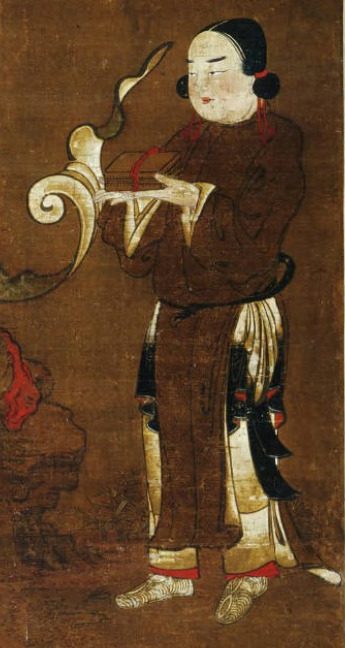
Zennishi Dōji (Princeton University Art Museum; reproduced here for educational purposes only)
Yoshiaki Shimizu has suggested that the connection between Myōren and his Gohō Dōji is meant to mirror that between Bishamonten and his son and primary attendant, Zennishi Dōji (善膩師童子), and highlight that the monk was an incarnation of the deity he worshiped. He also argued that Myōren’s nameless sister (not attested outside Shigisan Engi Emaki) - the character ZUN based Byakuren on - is meant to correspond to Bishamonten’s wife, Kisshōten/Kichijōten (presumably with spousal bond turned into a sibling one). I am not sure if this proposal found broader support, though - I’m personally skeptical.
Kongara Dōji (and Seitaka Dōji): almost Touhou
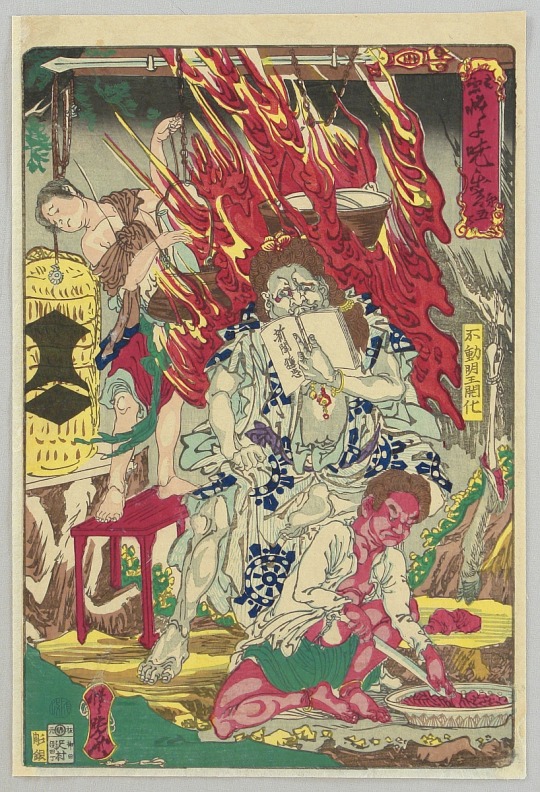
Fudō Myōō, as depicted by Kyōsai (via ukiyo-e.org; reproduced here for educational purposes only)
Kongara Dōji (衿羯羅童子, from Sanskrit Kiṃkara) and Seitaka Dōji (制多迦童子, from Sanskrit Ceṭaka) are arguably uniquely important as far as the divine dōji go - a case can be made that they were the model for the other similar pairs. They are regarded as attendants of Fudō Myōō (Acala), one of the “wisdom kings”, a class of wrathful deities originally regarded as personifications and protectors of a specific mantra or dhāraṇī. In Japanese esoteric Buddhism, they are understood as manifestations of Buddhas responsible for subjugating beings who do not embrace Buddhist teachings. Acting as Fudō‘s servants is the primary role of Kongara and Seitaka. As a matter of fact, both of their names are derived from Sanskrit terms referring to servitude. This is not reflected in their behavior fully: esoteric Buddhist sources indicate that Kongara is guaranteed to help a devotee who would implore him for help, but Seitaka is likely to disobey such a person. Interestingly, both can be recognized as manifestations of Fudō. This seems to reflect a broader pattern: once a deity ascended to a prominent position in esoteric Buddhism, some of their functions could be reassigned to members of their entourage. ZUN arguably references this in Mai and Satono’s bio, according to which “their abilities (...) are nothing more than an extension of Okina's.” Despite the aforementioned shared aspect of their nature, Kongara and Seitaka actually have completely different iconographies. Kongara is portrayed with pale skin, wearing a monastic robe (kesa) and with his hands typically joined in a gesture of respect. Seitaka, meanwhile, has red skin, and holds a vajra in his left hand and a staff in the right. His characteristic five tufts of hair are a hairdo historically associated with people who were sentenced to banishment or enslavement. He’s never portrayed wearing a kesa in order to stress that in contrast with his “coworker” he possesses an evil nature. It has been argued the fundamental ambivalence of dōji is behind this difference in temperaments.
While the pair consisting of Kongara and Seitaka represents the most common version of Fudō’s entourage, he could also be portrayed alongside eight (a Chinese tradition) or uncommonly thirty six attendants. The core two are always present no matter how many extra dōji are present, though. Appearing together is essentially their core trait, and probably is part of the reason why they could be identified with other duos of supernatural servants, like En no Gyōja’s attendants Zenki and Gōki (who as you may know are referenced in Touhou in one of Ran’s PCB spell cards, and in a variety of print works).
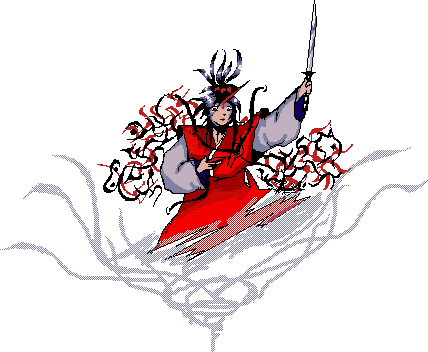
As for the Touhou relevance of Kongara and Seitaka, a character very obviously named after the former appeared all the way back in Highly Responsive to Prayers, but I will admit I am personally skeptical if this can be considered an actual case of adaptation of a religious figure. There are no iconographic similarities between them, and their roles to put it lightly also don't seem particularly similar. Much like the PC-98 use of the term makai (which I will cover next month), it just seems like a random choice. At least back in the day there was a fanon trend of treating the HRtP Konngara as an oni and a fourth deva of the mountain, but I will admit I never quite got that one. In contrast with Yuugi and Kasen’s counterparts, Kongara's namesake actually doesn’t have anything to do with Shuten Dōji. The less said about a nonsensical comment on the wiki asserting Kongara’s status as a yaksha (something I have not seen referenced outside of Touhou headcanons, mostly from the reddit/tvtropes side of the fandom) explains why his supposed Touhou counterpart is present in hell, the better.
Uhō Dōji: my life as a teenage Amaterasu protector of gumonji practitioners
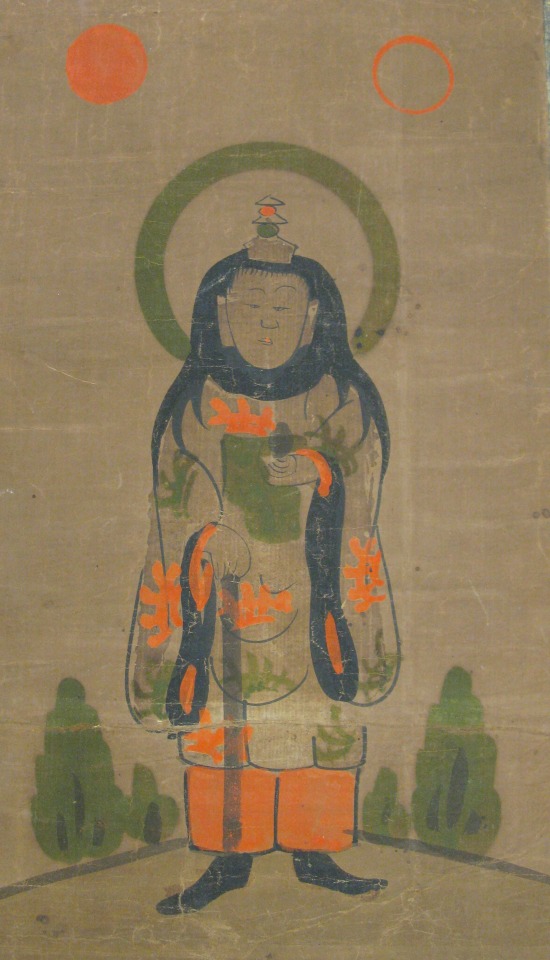
Uhō Dōji (Metropolitan Museum of Art)
Uhō Dōji (雨宝童子), “rain treasure child”, will be the last dōji to be discussed here due to being by far the single most unusual member of this category. Following most authors, I described Uhō Dōji as a male figure through the article, but as noted by Anna Andreeva, most depictions are fairly androgynous. Bernard Faure points out sources which seem to refer to Uhō Dōji as female exist too; this is why I went with a gender neutral translation of dōji. In any case, the iconography is fairly consistent, as documented already in the Heian period: youthful face, long hair, wish-fulfilling jewel in one hand, decorated staff in the other, plus somewhat unconventional headwear, namely a five-wheeled stupa (gorintō). Originally Uhō Dōji was simply a guardian deity of Mount Asama. He is closely associated with Kongōshō-ji, dedicated to the bodhisattva Kokūzō. The latter is locally depicted with Uhō Dōji and Myōjō Tenshi (明星天子), a personification of Venus, as his attendants.Originally the temple was associated with the Shingon school of Buddhism, though today it instead belongs to the Rinzai lineage of Zen. A legend from the Muromachi period states that Kongōshō-ji was originally established in the sixth century, during the reign of emperor Kinmei by a monk named Kyōtai Shōnin (暁台上人).The latter initially created a place for himself to perform a ritual popularly known as gumonji (properly Gumonji-hō, 求聞持法, “inquiring and retaining [in one’s mind]”).The name Kongōshōji was only given to it later when Kūkai, the founder of the Shingon school of Buddhism (from whose traditions gumonji originates), received two visions - one from a dōji and then another from Amaterasu - that a place suitable to perform gumonji exists on Mount Asama. After arriving there, he stumbled upon the ruins of Kyōtai Shōnin’s temple, so he had it rebuilt and renamed it. Subsequently, Amaterasu appointed Uhō Dōji to the position of the protector of both this location and Buddhist devotees partaking in gumonji in general. Most of you probably know that gumonji pops up in Touhou as the name of Akyuu’s ability in Perfect Memento in Strict Sense. ZUN describes it simply as perfect memory, but in reality it’s an esoteric religious practice focused on chanting the mantra of Kokūzō 1000000 times over the course of a set period of time (either 100 or 50 days). The goal is to develop perfect memory in order to be able to memorize all Shingon texts, though it is also believed to increase merit and grant prosperity in general. The oldest references to it come from the eighth century, and based on press coverage it is still performed today. ZUN actually never mentioned gumonji in a context which would stress the term’s Buddhist character. In Forbidden Scrollery Akyuu prays to Iwanagahime rather than to any Buddhist figures. I get the idea behind that, but I will admit I liked the portrayal of her religious activities in Ashiyama’s Gensokyo of Humans much more.

Gumonji aside, the second major point of interest is the connection between Uhō Dōji and Amaterasu. In the legend I’ve summarized above, they are obviously two separate figures, with one taking a subordinate position. This changed later on, though. At some point, most likely between 1419 and 1428, the two deities came to be conflated. As Bernard Faure put it, Uhō Dōji effectively came to be seen as the “Buddhist version of Amaterasu”. To be specific, as Amaterasu at the age of sixteen, presumably to account for the fact that a dōji would by default be a youthful figure. The treatise Uhō Dōji Keibyaku goes further and asserts that that Uhō Dōji manifests in India as the historical Buddha, Amida and Dainichi; in China as Fuxi, Shennong and Huang Di; and in Japan as Amaterasu, Tsukuyomi and Ninigi. In his astral role, he represents the planet Venus, but he can also manifest as Dakiniten and Benzaiten, in this context understood as respectively lunar and solar. He is also the creator of all of these astral bodies. The grandiose claims about Uhō Dōji, Amaterasu and other major figures were not exactly uncontroversial. It seems that especially in the eighteenth century the Ise clergy objected to them, presumably because they effectively amounted to their peers at Kongōshō-ji promoting their own deity to make the temple more important as a part of the Ise pilgrimage, which at the time enjoyed considerable popularity. The association between Amaterasu and Uhō Dōji nonetheless persisted through the Edo period, and despite protests voiced at Ise among laypeople Mount Asama was widely recognized as the third most important destination for participants in the Ise pilgrimage, next to the outer and inner shrines at Ise themselves. It is also quite likely that there was no shortage of people who would imagine Amaterasu looking just like Uhō Dōji. Ultimately the Uhō Dōji controversy was just one of the many chapters in Amaterasu’s long and complex history, and there was nothing particularly unusual about the claims made. There were quite literally dozens of Buddhist or at least Buddhist-adjacent figures she developed connections to (Bonten, Enma and Mara, to name but a few), and the Ise clergy took active part in this process. Buddhist reinterpretations of Amaterasu flourished especially through the Japanese middle ages. It was only the era of Meiji reforms that brought the end to this, cementing the Kojiki and Nihon Shoki inspired vision of Amaterasu as the only appropriate one. However, this is beyond the scope of this article. Worry not, though: the very next one I’m working on will cover these matters in detail. Please look forward to it. Bibliography
Anna Andreeva, “To Overcome the Tyranny of Time”: Stars, Buddhas, and the Arts of Perfect Memory at Mt. Asama
Talia J. Andrei, The Elderly Nun, the Rain-Treasure Child, and the Wish-Fulfilling Jewel: Visualizing Buddhist Networks at the Grand Shrine of Ise
William M. Bodiford, Matara: A Dream King Between Insight and Imagination
Bernard Faure, The Fluid Pantheon (Gods of Medieval Japan vol. 1)
Idem, Protectors and Predators (Gods of Medieval Japan vol. 2)
Idem, Rage and Ravage (Gods of Medieval Japan vol. 3)
Nobumi Iyanaga, Tachikawa-ryū in: Esoteric Buddhism and the Tantras in East Asia
Gaétan Rappo, Heresy and Liminality in Shingon Buddhism: Deciphering a 15th Century Treatise on Right and Wrong
Idem, “Deviant Teachings”. The Tachikawa Lineage as a Moving Concept in Japanese Buddhism
Yoshiaki Shimizu, The "Shigisan-engi" Scrolls, c. 1175
112 notes
·
View notes
Text
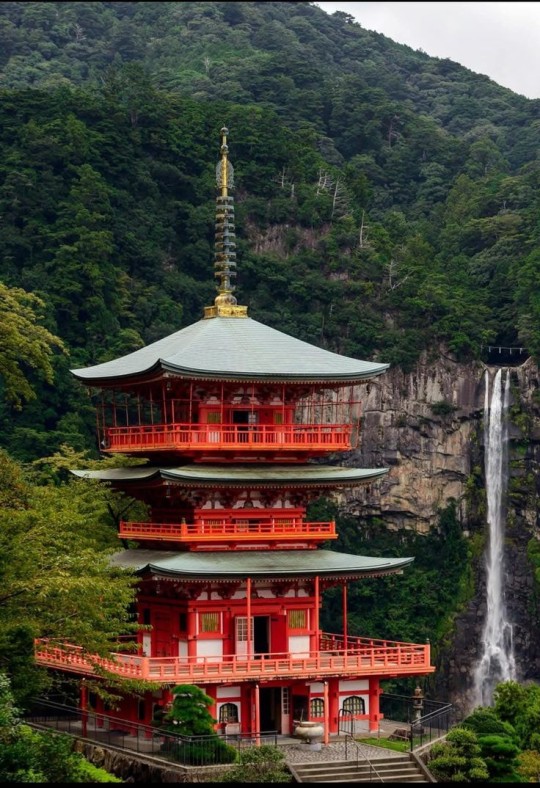
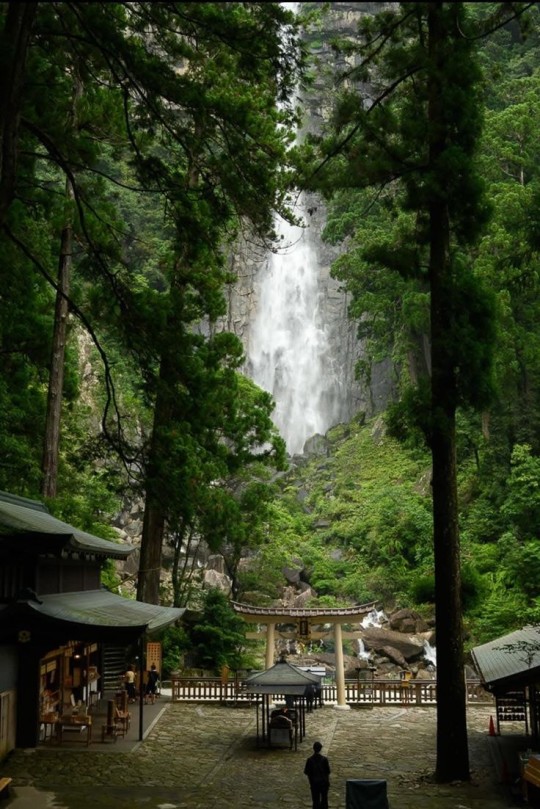
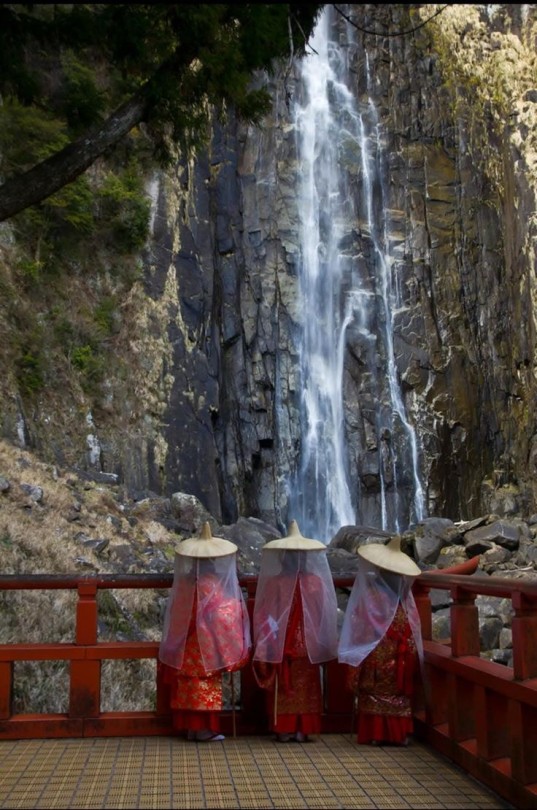
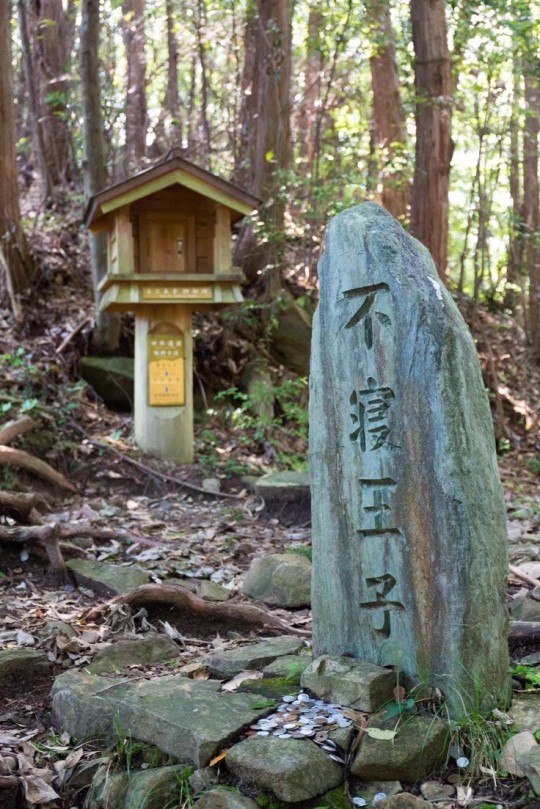

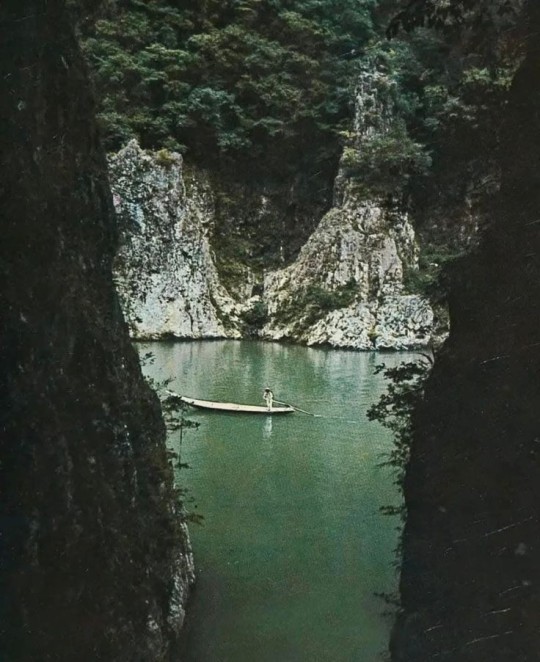
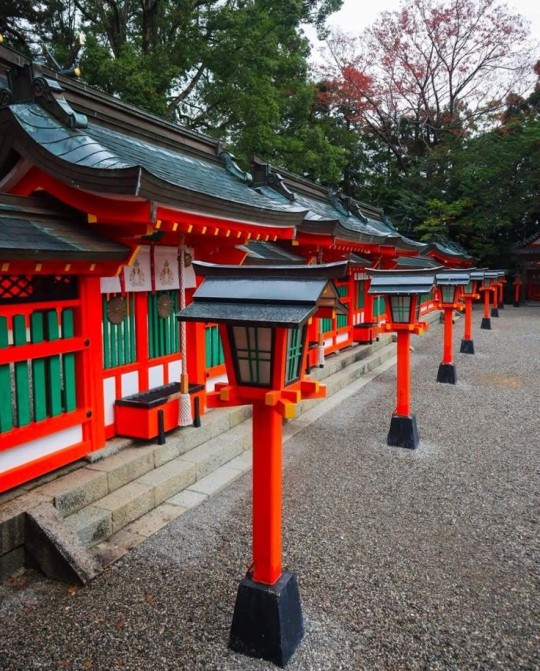

Nella penisola di Kii in Giappone, gli antichi sentieri del Kumano Kodo si intrecciano attraverso montagne boscose e attraversano antichi villaggi. Milioni di persone hanno viaggiato in questo sacro pellegrinaggio nel corso dei secoli, usando gli stessi sentieri coperti di muschio presi dai guerrieri samurai e dagli imperatori giapponesi. La leggenda narra che gli alberi, le cascate e le montagne siano le dimore di spiriti, rendendo il Kumano Kodo un viaggio in movimento di morte e rinascita. Nel periodo Heian (794 – 1185) il pellegrinaggio era in gran parte riservato all’élite religiosa e politica. La famiglia e la corte imperiale fecero un arduo viaggio dall'antica capitale di Kyoto a questa remota area, alla ricerca del cielo sulla terra. Storicamente, le montagne in Giappone erano considerate sia la dimora degli dei che uno spazio di ritrovo per gli spiriti dei morti. Per questo motivo, la regione montuosa di Kumano era sempre venerata dai seguaci dei sistemi di credenze politeiste del Giappone (che dovevano diventare collettivamente conosciuti come Shintoismo). Inoltre, il Kodo era uno sbocco ideale per le pratiche ascetiche, così come per la purificazione della mente, del corpo e dell'anima.
I siti sacri noti come Kumano Sanzan sono:
Kumano Hayatama Taisha
Kumano Nachi Taisha e il vicino Tempio Nachisan Seiganto-ji
Kumano Hongu Taisha .
Tutte le vie di pellegrinaggio Kumano Kodo conducono a Oyunohara , il Torii più grande del mondo, Questa struttura monolitica simboleggia la divisione tra il mondo secolare e quello spirituale; è l’ingresso ad un’area sacra.
Il simbolo di Kumano Kodo è il corvo sacro a tre zampe, Yata-garasu. Le tre zampe rappresentano il cielo, la terra e l’umanita’.
Kumano Sanzan ha combinato le fedi shintoiste e buddiste in una sola, conosciuta come Shinbutsu-shugo (letteralmente la convergenza del buddismo e dello shintoismo). L’idea che le divinità (kami) siano presenti in tutte le cose sulla Terra è profondamente radicata nella cultura giapponese dai tempi antichi. Il White paper ripiegato sotto forma di fulmini e appeso ai santuari delinea le aree in cui si ritiene che i kami presiedano. Dopo che il buddismo arrivò in Giappone nel VI secolo, i kami shintoisti diventarono, essenzialmente, manifestazioni di entita’ buddiste.
Shide, le stelle filanti di carta piegate a forma di bullone, spesso attaccate a Shimenawa (corda di paglia di riso), sono utilizzate per la purificazione nei rituali shintoisti e sono appese alle aree sacre. Lo shimenawa sulle cascate di Nachi indica la presenza di un kami (deità).
Gli Oji sono santuari sussidiari che fiancheggiano il Kumano Kodo e fungono da luoghi sia di culto che di riposo. La formazione di questi santuari è stata attribuita agli asceti di montagna Yamabushi, che storicamente servivano come guide di pellegrinaggio.
Più di 1.200 anni di storia shintoista e buddista sono documentati in queste montagne, motivo per cui il Kumano Kodo è stato insignito dello status di Patrimonio Mondiale dall'UNESCO.
“Questa è l’unica area sacra del mondo in cui due religioni coesistono in perfetta armonia”
15 notes
·
View notes
Text
Religious Imageries in JJK: The Conflicting Views of Shinto and Buddhism.
Disclaimer: This is not an explanation post, this is an observer post. I will try to sum up what I have observed so far.
Let's begin with the definition and history of both Shinto and Buddhism.
Shinto [神道]: Combined with the kanji of God/Kami (神) and Road /Michi(道), Shinto literally means The way of the God(s). It is the indigenous religion of Japan and is as old as Japan itself.
Shinto belief is polytheist and animistic as it has almost 8 million gods that are derived from nature and natural things. This religion revolves around "Kami". Kami can be manifested from anything, but the most important Kami are the natural ones.
Sun, Rain, Earth etc. The most important central Kami is Amaterasu the Kami of the Sun. The exact history of Shinto is untraceable but it was mentioned in the Yayoi Period (300 BCE to 300 CE) of text.
Shinto describes the world as a inhabitant of the human and the kami they worship. It describes the world as founded by the kami and once humans/ living beings pass away they become kami as well.
It is safe to say that Shinto belief described humanity as living being as a whole, where even after death they don't living. The idea of morality or immorality is also absent from it. The existence of Kami is the manifestation of humanity itself and not separated from human beings.
Fun Fact: Chinese indigenous religion 'Dao' has the same characters as Shinto's kanji. So it might be possible that Shinto actually comes from Chinese Daoism.
Buddhism: Buddhism is an Indian religion. It revolves around the teaching of Buddha. Buddha is no myth. Even though convoluted, early texts gives his name as "Gautama" and he lived around 5th to 6th Century BCE.
In India his name is mostly known as "Siddharth". He was born in Lumbini in present day Nepal and grew up in Kapilavastu. The border of India and Nepal, a town of the Ganges plain of present day Bihar and Uttar Pradesh.
The most notable person who helped spread Buddhism around India so much that it was spread in the NEA and SEA is Emperor Asoka (304-232 BCE) from the Maurya Empire (322-180 BCE).
Buddhism circles around the suffering of human, the circle of life and Karma (deed). Where a soul is constant as it is being born in this world as human, it goes through the cycle of life (suffering) and it dies.
It also talks about Dharma as the ultimate truths, also that humans are born to fulfill a certain role. Moksha: The liberation from the earthly desire which should be the ultimate goal of a human being.
It also draws the line between God and humans as Gods are separated from the earthly matters and pushes the idea of Gods creating the universe and the creating the humanity.
The Mix of both Religion:
Though the idea of Shinto and Buddhism is pretty contradicting it existed with each other for centuries.
Even though Buddhism entered in japan in Yayoi Period (250-538 AD), it became popular in Asuka Period (538-710) due to buddhist sect taking the rein of the country. Initially Buddhism and Shinto coexisted and even mixed with each other. It was called Shinbutsu-Shougou. However, later it was forcefully separated by Japanese nationalists in Meiji Era (1868-1912) and Shinto became the state religion of Japan with the Emperor being worshipped as Kami the descendants of Amaterasu.
Cursed Spirit: The reason I am writing this is not because the obvious depiction of buddha, Buddhist shrines and mention of clans and sects etc. What caught my interest was that the idea of "Cursed Spirit".
The textbook explanation of Cursed Spirit is that the reaction of human emotions but as we see it is actually the manifestation of human existence. As long as humans will exist, curses will also exist.
Which pretty much resembles the idea of Kami.
The timeline: The golden era of jujutsu was Heian Era which historically existed between 794-1185 AD. Almost a century after Buddhism was introduced in Japan. Also in that era Sukuna rose up as the king of curses. Which may indicate the clans existed even before and Sukuna existed throughout.
Characters like Kenjaku and Tengen their birth and living timeline are unknown but they might just as be as old as Japan, like Shinto.
Getou and Megumi are the only two people who can control curses as Shikigami. Which is another japanese Shinto belief that has also been associated with "Curses" during Heian Era.
The people who used to control Shikigami were called Onmyoji (Yin-Yang Master).
Both of them were either antagonised or villfied by the jujutsu society at one point.
Also the most important part that made me think about this is...Sukuna's domain.

This resembles an average Shinto shrine...

The Tori is missing.
Insanity.
Anyways. I am not saying that Gege is making one religion look bad and another look good. It's not true and actually far from it. Though contradiction, Gege shows the good and bad of both sides. Kenjaku is bad and the higher ups are as worse as him.
Personally I think this is a battle of belief of the world with a main character emerges with no beliefs at all. Itadori Yuuji hates Sukuna but not by the virtue of being Gojo's student but his own opinion about him. In the latest chapter he says "Human beings are not a tool, so nobody's existence is premediated." Which contradicts the idea of "Dharma".
The message might be "If you want to change the world, you have to diverge from the existing path and forge your own."
25 notes
·
View notes
Text
Kyoto
Heian Jingū
Enshrined Kami: Emperors Kanu and Komi, the first and last emperors to reside in Kyoto
Prayers Offered: Peace, the well being of the family, and protection against danger

Heian Jingu enshrines Emperor Kanmu (r. 781-806), who created Heiankyo (present-day Kyoto). While he was the only kami enshrined when the shrine was built in 1895, Emperor Komei was added in 1940 on the 2,600th anniversary of the nation’s founding. It was an unusual case, in which one emperor was enshrined as a kami more than a thousand years after his death, and a second emperor (only distantly related to the first) some forty-five years later. The shrine was established as much as a commemorative emblem of the past glory of Kyoto as a religious institution. Of course, it is not the only one in Japan to enshrine emperors. But the others are simply shrines, whereas Heian Jingu is strongly symbolic, dedicated to both the founder of the old capital and the last emperor to reside there. Kanmu is revered as a clever and creative leader who built the city that was the center of Japanese culture for the better part of a thousand years. Komei, on the other hand, is best known for his anger at the forced entry of Commodore Matthew Perry’s black ships in 1853 and the edict he issues in 1863—impossible by then to obey—to “expe, the barbarians.” By the time of Komei’s death at the age of just thirty-five in 1867, the country was in disarray, and the wholesale import of Western culture into Japan had begun. But what was hardest for the citizens of Kyoto to swallow was the prospect of the young Emperor Meiji relocating to the country’s new eastern capital, Tokyo.
—Pages 106-107

Hirano Jinja
Enshrined Kami: Imaki no Sume Ōkami, Kudo no Ōkami, Furuaki no Ōkami, Hime no Ōkami
Prayers Offered: To find love and marriage, revitalization and new beginnings, protection against danger, and safe childbirth

The four kami enshrined in Hirano Jinja are neither widely known nor well understood. The shrine describes Imaki okami as a god of revitalization, Kudo okami as a deity of the cooking pot, Furuaki okami as a deity of new beginnings, and Hime no okami as a deity of fertility and discovery. The Engishiki (967) mentions the shrine as guardian of the imperial household kitchen. It seems that Emperor Kanmu gathered these kami together in one shrine and founded Hirano Jinja in the northwest corner of Kyoto to act as a protector of both the city and of the imperial court. Kitabatake Chikafusa (1293–1354) was apparently the first to consider the kami as ancestral, assigning them to the Tahira, Minamoto, Oe, and Takashina branches of the imperial line…Shinto scholar Ban Nobutomo (1773–1846), in his research into banshin (foreign kami), stated that the kami of Hirano are ancestors of the Paekche dynasty. However a spokesman for the shrine believes Nobutomo erred in his translation of certain words, which drew him to an erroneous conclusion. A related theory identified Hime no Ōkami with the mother of Kanmu, Takano no Niikasa. If so, it may be one reason why Kanmu, whose mother was descended from a Korean king of Paekche, valued the shrine. Perhaps incidentally, the term “Imaki” is applied to Korean immigrants in the Nihon shoki…
…considered “eminent kami”…received regular offerings from the imperial palace. The kami of Hirano were considered very powerful, and the hereditary priests who controlled the shrine were from a clan of tortoise-shell diviners called the Urabe. Tortoise-shell divination (kiboku), imported from China through Korea, became one of the main forms of divination regulated under the Council of Kami Affairs (jingikan). The Urabe were an important clan of hereditary Shinto priests (jingidoke) considered one of the “three houses of Shinto” along with the Shirakawa and Nakatomi clans. They divided into the Hirano and Yoshida clans, with the Yoshida becoming one of the most influential kami clans throughout the late medieval and Edo periods. The Yoshida controlled the right to appoint new priests and rank shrines. The Hirano were transcribers of the classics and experts on the Nihon shoki. A compilation of research, called Shaku Nihongi, written by Urabe Kanekata, earned the family the sobriquet “house of the Nihon shoki.”
—Page 109
…In the Heian period it was considered one of the “major seven” shrines, along with Ise, Iwashimizu, the Kamo shrines, Matsuo, Fushimi Inari, and Kasuga. It was associated with a shinbutsu shugo (syncretistic) belief known as the “thirty tutelaries” (sanjubanshin), which originated with the Tendai monks of Mount Hiei in the ninth century. This was a belief that thirty kami (presumably chosen by Tendai monks) alternated daily to protect the Lotus Sutra. The kami of Hirano was also included in this grouping.
—Pages 110

Iwashimizu Hachimangū
Kami Enshrined: Hachiman okami (also known as Hondawake no mikoto and associated with Emperor Ojin), Hime okami, and Jingu Kogo (Okinagatarashihime no mikoto).
Prayers Offered: Protection against danger, safe childbirth, and the attainment of goals.

Iwashimizu represents the emergence of Hachiman as a god of war as well as exemplifying the Kami’s identification with Buddhism. It is also significant as the the kami’s second enshrinement close to a capital city and seat of power. (For the beginnings of Hachiman worship, see the entry for Usa Jingu.) The first was in Tamukeyama Hachimangu in Nara as protector of the Great Buddha of Todaiji in 752. After that time, the connection between Hachiman and the imperial court grew stronger. In 855 Hachiman was again called upon to “protect the nation” when the head of the Great Buddha of Todaiji suddenly fell off during an earthquake. Emperor Montoku launched a campaign to rebuild the Buddha shortly afterward and the first place he turned for assistance was Usa Jingu. For the first time the imperial message addressed Hachiman as “awesome Daibosatsu” (great Buddha) and called upon him to “protect the emperor [country] to eternity.” At the same time, a statement was issued that the kami who assisted in this project would gain “merit” (in the sense of Buddhist enlightenment). It was an important step in acknowledging kami as “trace” manifestations of the “original ground” (honji-suijaku) of the Buddha.
—Page 112
There is an interesting story related to the bamboo of Otokoyama. In 1880 Thomas Edison sent one of his researchers, William H. Moore, to Japan in search of good bamboo to use as light bulb filaments. It is said that he had tested six thousand materials, but the bamboo taken from a fan lasted the longest—200 hours. Moore was directed to Kyoto and more specifically Otokoyama, and the bamboo he found there made a filament that lasted close to 1,200 hours. Ironically, the rock that makes up Otokoyama is a poor surface for growing bamboo, as a result of which the type that grows there is harder than normal. It became part of Edison’s incandescent lamp for the following ten years, and the inventor maintained close ties to Japan… It is strange to think that the mammoth Japanese electric industry began with Edison, and that Edison’s light bulb began with the grace of the kami of Iwashimizu Hachimangu. Today there is a monument to the inventor on Otokoyama, and a Festival of Light has been observed since 1999. It is also possible to purchase ema votive plaques bearing an image of Edison.
—Pages 113-114

#Heian Jingū#Heian Jingu#Hirano Shrine#Iwashimizu Hachimangū#Iwashimizu Hachimangu#Shinto#Shinto Shrines A Guide#Photos#Kami#shinbutsu shugo#Buddhism#Thomas Edison
3 notes
·
View notes
Note
Do you have any more headcanons about the Senju?
Here is a loooooong post with assorted collection of Senju clan HCs for you! They main apply to the Warring States era and early Founders Era. Some of them are new, some I've picked up from some of my older posts.

Disclaimer: This is HC's of the general culture. People are people and won't act in perfect alignment with the norms or social etiquette that is encouraged, may interpret them differently or disagree with them entirely. Hashirama and Konoha also brought drastic change which ended or drastically changed some of these traditions and norms.
CW for a bunch of stuff including but not limited to war, injury, pregnancy, childbirth, sex, abuse, death and more. Reader discretion is advised.
As far as religion goes the Senju lean more into Shinbutsu-shūgō (Syncretism of Shintoism and Buddhism), but a number consider themselves to have little to no attachment to spirituality. Ancestor worship is the most commonly displayed spiritual practice among Senju.
Ashura fought and worked hard for his abilities and gained much from the support of others, and the Senju towards the end of the WS era have managed to breed certain beneficial traits into becoming extremely common within their clan. This includes possessing a genetic anomaly that gives 9/10 Senju a natural affinity for two of the five basic chakra natures, as opposed to just one which is the universal norm (with the exception of a handful of clans with rare kekkei genkai). Another incredibly common trait in Senju was in fact passed on from their ancestor Ashura, which is immense physical strength, stamina and energy (see more notes in next point). Their natural physical strength and muscle density is immense, allowing them to achieve feats that would otherwise be incredibly difficult or impossible to achieve without enhancing your ability with chakra and pushing the natural limits of your body. Stamina can be used to mold into chakra for performing ninjutsu techniques. Having lots of stamina allows them to perform many or stronger techniques while still having energy left to remain physically active. Their strong life-force, which they share with their relatives the Uzumaki, makes them hard to kill. They can be severely injured but still cling to life, even if they may not be able to keep fighting at the time. These traits have allowed them to keep up with the rival and otherwise unmatched Uchiha clan. Their average is what others would consider impressive.
Notes on Physical Energy - The Senju and the Uzumaki Life-force I interpret this as the strength of the bond between the body and the soul. Having strong life-force enables you to stay alive even when your body is put through trauma or illness that can be lethal. It doesn’t mean you are immortal or invulnerable, that you won’t feel the pain or other symtoms of the trauma, or not needing to recover, only that it won’t kill you as easily as it might another. It’s what maintains life within you. Associated with both the Senju and the Uzumaki, but the latter in particular Vitality I interpret this as the energy that drives you to do stuff, to be active. If life-force is the energy that maintains your fundamental state of being alive, vitality is the energy that drives you and makes you feel alive. It’s what allows you to feel healthy and capable and energetic. It’s the energy that gives you the strength and enthusiasm to do things. It is the drive to act, to grow and develop. You could describe a person with lots of vitality as someone who is spirited, passionate, as vigorous, as lively or energetic. The opposite of vitality could be lethargy, sloth or apathy. Associated with both the Senju and the Uzumaki Stamina I can keep doing X activity for Y amount of time at maximum and high intensity before I start to feel tired. It’s about maximizing the energy you put into an activity. Eg. How long can you keep running at the speed you started at before you begin to feel out of breath, your legs burning and feel the need to slow down or take a break? (Can also be applied to mental stamina, but the Yang energy, which is what Ashura’s descendants inherited, is specifically associated with the physical body) Associated with the Senju Resilience Is your physical ability to withstand or adapt and maintain function through changes in circumstances, adversity or difficulties such as illness, injury or other difficult physical demands, and then recover once it has passed. How quickly and effectively you will ‘bounce back’, such as recovering from an injury, or adjust and adapt to the altered circumstance, such as managing an acquired physical disability because of an injury. (Can also be applied to mental resilience, but the Yang energy, which is what Asura’s descendants inherited, is specifically associated with the physical body) Associated with the Uzumaki Physical strength What is sounds like; the force or resistance your muscles are able to exert on physical objects. How much can you lift? How hard can you punch or kick something? If you are being pushed how hard can you push back? This strength manifests in the density of their musculature, which is insane. Not only does their musculature allow them feats of physical strength and endurance, but it also makes their bodies sturdier to an extent; as it supports and protects the integrity and stability of joints and bones. (IRL Muscle density refers to the amount lean muscle tissue in comparison to the amount of fatty tissue in your body. Specifically the amount of fat between the fibres of muscle. Denser muscle with less fat between the fibers allows for increased strength as they can contract more efficiently and with more force. Does not translate to the size or mass of muscles however, or even how 'fit’ you may appear aesthetically. You can have visually large muscle mass but have low muscle density and vise versa.) Associated with the Senju.
They are typically run by primogeniture, where the oldest child, regardless of gender, of the current clan head will by default be raised to become the heir. However, if the current or future clan head displays physical or mental weakness, inability to lead or doesn’t seem to put the best interest of the clan’s current and future welfare and survival before their personal ones, then they can be deposed and replaced by someone the clan deems more fit for the role. So the Senju has no ‘main branch’, although in some cases the line of succession within a specific family has remained unbroken for several generations. As is the case with Hashirama's family.
The Senju is a clan large enough that nobody knows everybody, but small enough that everyone can recognise anyone, and new faces do stick out.
One is typically most familiar with those who are of their generation and age group, as they would have all been trained together from a young age.
The Senju have a tradition of gifting girls and women jade bracelets. A girl will receive her first bracelet by her father when she's young, and might be larger so that she can grow into it, one from both her parents when she comes of age at sixteen, one from her mother the day she gets married, and one from her lover before she marries as a symbol of enduring love, loyalty, and willingness to care for and protect the recipient. The jade bracelet gifted from her lover is the only piece of adornment that tells the world a Senju woman is in a committed relationship. She may also be gifted one by her new father-and mother-in-law when she marries, and another by her husband when she has given birth to a child. Some Senju women only possess one bracelet, while others have many. It is no requirement to always wear them, and some are maybe unable to wear the ones they received as children. Most also remove them for training, assignments or activities where it may be damaged. Others choose to always wear them and rarely, if ever, remove them, and some would have to break it order to get it off. But not wearing it at all regularly was seen as bad luck as the stone was seen as living and needed to be cared for and connected with to obtain the benefits.
It is typical to wear these jade bracelets on ones non-dominant hand, and can be in the form of solid bangles, hinged bangles or beads on a string and tied onto the wrist.
Jade was seen as a symbol of prosperity, success, good fortune and longevity, as well as love, beauty, sincerity, physical strength and health, clarity of mind and purity of spirit. All aspects and traits one would want to attract for the wearer throughout her life. Jade was also heavily associated with the earth, its color and connecting the Senju to their forest.
Jade is also valuable overall so they are precious gifts that can be sold if the woman and her family runs into financial difficulties.
The Senju does allow non-Senju to marry into the clan, but not often and not casually. Still about 20% of all Senju are actually outsiders who were adopted into the clan when they were very young. Adoption is the far more common way for an outsider to be accepted into the Senju. Many of them were not raised to become shinobi the same as any child born a Senju was, though some were, it would depend on the child in question. This has on occasion given the Senju a reputation as child stealing, although these children have usually been orphaned and displaced by the war. Not to say it has never happened that a child was taken in against the wishes of their parents, or snatched from another shinobi clan.
Whenever a non-Senju marries into the clan they are almost always a civilian with no shinobi background.
If you as a Senju did wish to marry within the clan, as a rule choosing anybody that is closer to you than at least five generations removed (i.e. your closest shared ancestor is your great- great- grandparents) will be considered unsuitable and is discouraged, if not straight-up forbidden.
Having shinobi from other shinobi clans marry into theirs is very rare because of the risks it can entail to bring shinobi into the heart of their home. Clans were far too often pitted against each other by employers regardless of any alliances they may have, so it was risky to bring in new members who's loyalty could easily be swayed by sentimental feelings and loyalty for their original clan. Mito was allowed to marry into the clan because the Senju and Uzumaki have historical ties and an overall good to neutral relationship, and because she was the one Hashirama chose so an exception was made.
Respect for your parents and elders is an integral part of social etiquette. Seniority can trump rank. A younger member with a high rank is still expected to respect and take into account an older member's input and experience. The parents of a child are responsible for teaching their children about this etiquette, as a child being disrespectful towards an elder, be they a sibling, parent, distant relative or otherwise, will shine a bad light on their family. Hashirama’s public and loud display of anger towards Butsuma during Kawarama’s funeral broke both the etiquette of respecting your elders and parents, and respecting the dead.
Teamwork and comradery is highly encouraged and the Senju are known for their efficiency when working in squads of five to ten individuals. Their tactics and ability to quickly regroup and adapt to a situation as a unit is drilled into them from a young age. Some of these tactics have been specifically formed to deal with Uchiha who have the sharingan, exploiting the weaknesses of the dojutsu such as blind spots and any disproportion between the sharingan taking in information and the body being able to act upon it. Though some find them predictable because of this, it's nonetheless acknowledged that they are highly efficient and dangerous when they are working together, which is why opponents may attempt to divide the group. (Also one of the reasons why I believe the Senju died out. They had thrived on their methods during the WS era but were uprooted by the new mixed team system and became weaker for it, dying more frequently in combat.)
As the Senju put a lot of emphasis on camaraderie, they promote relationships of trust and devotion between peers over strictly familial or filial ones. Treat and love all your peers as your brothers and sisters. Get along, be respectful of each other, and stay close. Love and support each other for life.
You are considered an adult by the age of 16, at which point you can attend clan meetings get a say in how the clan is being run. At this time making it to 16 boosted your chances of living to 40 to about 80%. (Before the years of the plague around 790CE, about 200 years before Hashirama, which resulted in what was necessity and desperation turned into a tradition of deploying children as young as 6 and 7 into war, those under 13 would rarely be given missions, much less be a part of open combat. If they were brought into the field, their involvement in actual combat was minimal at most, and instead served to help out at the campsites, help care for wounded and such things.They were still trained hard from early childhood, and were expected to be fit for combat by fifteen at the latest, but by then most would have been able to form enough strength and ability to actually keep up reasonably well with the adults. But once Hashirama became clan head he pushed for strictly refusing anyone under 15 to be given missions, and nobody under 16 was to be made to participate in war campaigns and had to go through an evaluation of their skills before being allowed to do so.)
You are considered eligible for marriage by 18 for boys, and 20 for girls.
Having children before that point is absolutely not encouraged. The desire was for one's body to be fully developed, strong and healthy before you decide to have a child, regardless if you are the one who will be pregnant or the one who impregnates. The average age for having your first child was somewhere between 20 and 25 for women.
Menstruation and contraceptives HC
The Senju does not practice polygamy or concubinage, and having children outside of marriage is discouraged as it makes keeping track of who is related to who far more difficult.
A woman could have children without being married or even have the father involved in her life at all, and it wasn't considered bad as much as impractical, but it would be expected of her to still know who the father was so that the child's lineage could be accurately recorded for future reference. In these cases the children would be recorded as members of the bloodline she was born into, but still with a note of their paternal ancestry.
Contraceptives and abortifacients were considered incredibly common medicines and widely used by the Senju so unexpected or unwanted pregnancies carried to term were rare. Procreation however is your duty to the clan, and there is a general expectation and pressure that all members should sire and raise at least one child in their life, and becoming a parent would boost one's social standing within the clan a bit.
It was considered more acceptable for a woman to have several children by different fathers, than it was for a man to have several children by different mothers. Again it comes back to maintaining the bloodlines. Just one man somehow persuading multiple women even in a short amount of time to have his children could spell a great deal of trouble down the line, if there were too many half-siblings catching an interest for each other. A Senju displaying behavior like this and carelessly undermining the lasting well being of the entire clan for his own gratification could end up being severely reprimanded, as in have his ability to ever have any more children removed. Permanently.
Marriage traditions are overall practical and uncomplicated. Very rarely a grand affair and was typically small and intimate. At it's most basic the couple more or less just has to state they take each other to be their respective partner in marriage, in front of a witness, and it's considered legitimate once the couple has been noted in what can be described as a family registry. Having a small celebration with close friends and immediate family is not unusual though.
There is a lingering tradition of asking for the father's permission to marry a daughter, but more often than not the prospective couple have already entertained a relationship for a while, and frankly asking for permission is just a curtesy and display of respect. If the family dissaproves then elopements are common. And the clan overall usually don't care much for such drama, unless one of the pair is a non-Senju or is a Senju but turns out to be too closely related to the other. If it's the latter case, then the pair's marriage will be considered void and they will not be allowed to live together, and that however can create some significant drama.
While procreation is is very much promoted as a duty and necessity for the clan's future, sex is also seen by the Senju as entertainment and socialization, and something to be enjoyed between equals, regardless if it's between casual lovers seeking a moment of escapism during a campaign, or a married couple in their shared home. Known for their open hearted and casual view on the topic which some find uninhibited and offensive. Although no self-respecting Senju would be caught dead in a brothel or ever dream of paying somebody for sex, they are often known to be unabashed flirts, both towards other Senju and outsiders, and to outsiders they would seem to not strictly limit themselves to their marital partner, and premarital, relational, recreational and casual sex is normal. Some non-Senju find this alluring and enticing, others are appalled and see this behavior as licentious and inappropriate.
The Senju however often also think other clans are too stiff and restricted in the way they are allowed physical expressions of love, sexual fulfillment and even just platonic affection. Life is way too short for that.
While polygamy was not accepted within the Senju, polyamory was generally fine, and both men and women could have consensual extramarital relationships and lovers and most would look the other way. As long as it was done discreetly and with one's marital partner's consent to such an arrangement, without humiliating them by publicly favoring their lover, and you still respected, honored and performed your role as a husband/wife or father/mother. Having at least one child with one's spouse was also generally a requirement for others to be accepting of a couple seeking any emotional or physical fulfillment or other connection that could not be found within their marriage. And again. Having children outside of one's marriage was strongly discouraged for bloodline and record reasons.
While polyamory, sexual and romantic relationships outside of marriage weren't necessarily frowned upon, and one was overall expected to be discreet, attempting to actively hide and deny the existence of these relationships very much was. It signaled shame for what they were doing and likely was doing something that was not a part of the agreement between them and their partner, and was seen as manipulating and betraying the mutual trust and respect between a married couple.
Divorce was a possibility, but rare. If one partner started favoring their extramarital lovers and relationships over their marital and familial ones, or mistreated their family, then the other partner or even their relatives could bring up the issue and demand a separation. Although during the era of warring states, a marriage usually didn't last long enough for a divorce to come up as a necessity, as one or both of the pair were likely to die in the line of duty fairly young. When that happened, it was not at all uncommon, encouraged in fact, for the surviving partner to remarry if they so wished.
The “Will of Fire” before Hashirama came along was a philosophy of the Senju, but it was different. It centered the current and future prosperity of the clan and the bonds you had with others within it and it alone, for your family and friends, not a village. A Senju during the WS era and early founders era would speak of the Will of Fire and in doing such mean something song these lines: “Fight for each day, never relent but if you believe you are going to die ensure you don’t go down without a fight.” “I will stay alive for the prosperity of my clan, I will fight to let all those I love thrive for one more day, but if I have to die in the process of securing their future I will take my enemies down with me.” “Fight to stay alive for the future of your clan, let that drive burn within you…but if you see the end ahead of you, make sure you let your enemies burn down with you.”
Speaking ill of or disrespecting the memory, resting-place or places for memorial of the dead is deeply frowned upon
Disciplinary action can be physical and very unpleasant depending on the offence.
'Tough Love' is the dominating norm, and coddling children too much is considered deeply detrimental to their future.
Honor your clan. Wear your crest with pride and dignity. When you wear your clan's crest, you represent it, so never act in a way that will bring shame upon it and all others who wear it, have worn it and will wear it in the future.
Life is fleeting and impermanent, and death is an inevitable part of life. Everything ends one way or another. Accept this irrefutable truth. Train hard, and fight with discipline and vigor and with the anticipation of death, and seize and enjoy the time between. Celebrate the things you fight for, love deeply, and find pleasure in the simple things when you can.
Don't speak without thinking, and speak only when you have something worth saying. Senju can be considered blunt, but overall sincere.
Do not waste food or drink. If you really do not wish to eat or drink what you are offered for some reason, accept it politely but leave it without eating or drinking it. Food was frequently scarce during the WS era, so refusing food was not only impolite but also just plain wasteful.
Maintain good hygiene. When in the field, take all opportunities that are offered to wash up. Keep your clothing and equipment clean, neat and maintained as well. Treat your belongings well, or they might fail you when you need them, and they may not be easy to replace. Treating your belongings poorly or having a dishevelled appearance can not only be cause of disapproving looks, but even disciplinary action. You represent the Senju and a higher class of professional soldiers, you should look and act the part.
Variations of games such as capture the flag, dodgeball, episkyros and tag are a common part of training in order to promote dexterity, teamwork, strategic thinking, perception and taking swift decisive action based on the circumstances.
Some acts of disobedience are more acceptable than others, and it is usually rather a matter of if you get caught doing it. For example, if you get caught sneaking out of the house at night you'll get scolded or disciplined for being caught, rather than the act of trying to sneak out itself.
Shinobi children often had many siblings, and parents that could be away from the home for extended periods of time or die suddenly, so being able to help care for their family by performing domestic and household tasks and being self-sufficient was important regardless of gender. This responsibility particularly falls onto the oldest child, but everyone is expected to pull their weight when needed and however they are able. The parents or closest living adult relative are the ones expected to make sure their children gain these skills.
A shinobi will have to do and endure terrible things, you are expected to be relentless, cold, and uncompromising in battle, but you should always separate who you must be on the battlefield from from the one you are at home. You have to learn this. If you get consumed by anger or pain or grief and can't function off the battlefield, or start engaging in antisocial behaviour and needless cruelty towards fellow Senju, civilians or even enemies in some cases, you are a burden to the rest of the clan.
It is alright to grieve, but you should not let it, or any other emotion for that matter, consume you. That makes you a problem. Don't be a problem.
Treat guests with respect and hospitality. Although the Senju rarely bring outsiders into their settlement, they are excellent hosts when they do. And once the village was founded and you visited a Senju household, you would always be offered to at least sit down and have some tea before you left.
If possible the Senju prefer to bury their dead respectfully in coffins, but are also frequently known to also burn them if they can't bring the remains with them to be buried. In those cases a portion of the ashes are typically retrieved to be buried or spread elsewhere. Worst case the remains will be left where they have fallen if circumstances makes them unrecoverable. Sadly that is an all too common reality. Regardless of how or if they were given a proper burial or sendoff, the dead are primarily honored at household shrines and in memory groves.
There are a two memory groves in the Senju's forest, several centuries old but the clan does its best to maintain them, because they are very important to them. They are essentially parts of the forest that has become places for honoring and remembering the dead. After the remains of fallen members of the clan who couldn't be retrieved and buried properly are burned, a portion of the ashes will be gathered and brought back home then buried or spread in these groves. But those who's remains couldn't be found or retrieved, buried or burned at all are also given space for remembrance. There are no headstones or markers, but like the rest of the forest there are statues of Jizo and the Buddha, as well as shrine-like formations set up where lanterns can be lit, incense, offerings, and such can be placed. The Senju visits these mossy groves to remember and honor their fallen friends, family and ancestors, named and unnamed, to pray and to meditate in the quiet and peaceful setting.
When you visits it is customary to treat the grove with care and respect, to keep the space cleared of branches that may have fallen from the trees, perhaps take the time to clean the statues and shrine, remove wilted flowers, burned out incense and offerings worn out by the elements. Children are frequently brought to the groves and allowed to help keep them maintained and to gain an appreciation for the significance of the sacred space. Food offerings are not left in these groves as it attracts wildlife, so such offerings are typically left at a household shrine.
During Obon these groves gets extra attention and visitation.
Because of their habit of adopting outsiders into the clan, the physical appearance of the Senju can vary greatly and the clan has seen everything from very dark skin to very fair, from black hair to white, and everything in between such as hues of red, brown and golden blonde, including rarities such as light blue, purple and green. Though brown hair and dark eyes are the dominating features.
The birth of a child is a momentous occasion that will be celebrated more than most others. It is one of the occasions where the father of the unborn child (assuming he's alive and that the mother wants him there) is expected to drop everything and be present for the birth and any siblings will be called home. The father of an expectant mother in the late stages of pregnancy will usually not be given assignments that he can't easily return home from, and if he still knowingly accepts such an assignment it may make him look bad. The father will be present during the birth to support the mother and will be expected to help if he's needed, but a midwife or an experienced mother or other trusted female relative or friend will be the primary attendants of the birth.
After the birth, the placenta will be wrapped in cloth and buried, returned to nature, by the father and any siblings of the newborn.
It is typical that the child's name won't be shared until it is a week old, at which point available friends and family will celebrate the strength, efforts and continued health of the mother and the new addition to the family and the clan with gifts, talismans and blessings. But from the moment the baby draws breath, it should not be touched by anyone other than the mother, father, it's siblings and the midwife who delivered it for a month, as to make sure it is strong enough to not catch any illnesses.
While giving new clothes to a couple for their wedding day is considered optional, and is usually skipped in favor or simply thoroughly washing and mending their best garments to wear, it was definitely encouraged and seen as auspicious to gift new blankets, swaddles, bedding, and clothing to a newborn.
Although life expectancy was short and that it was rarely easy or kind to shinobi, it did not stop people from celebrating and hoping for the child to live a long, happy and prosperous life.
During that first week the family would be given time of solitude and bonding, and the mother should be allowed to rest. She may walk around if she's feeling ready for it, but she should refrain from doing much else than caring for herself, her needs and those of her new baby.
While the mother recovers from the birth and tends to the infant, the father will get all the responsibility to look after her and the rest of their family by doing household chores, making sure the mother is fed hearty and nutritious food so that she may regain her strength, that she gets opportunities to bathe, he'll look after their other children, and so on. While others are meant to offer space and quiet to the family, close relatives like the parents of the mother and father or their siblings may visit to offer support and help with these tasks, or be there in the place of the father if he's for some reason not in the picture, but if he is he's the one expected to be there for the mother and their family at this important time. Shrinking away from this very important responsibility paints him in a bad light which can be cause for separation and affect his social standing within the clan. The long, laborious and dangerous but invaluable undertaking of carrying and birthing a child into world, to the clan, should be treated with nothing less than respect, support and celebration.
Unless circumstances demand otherwise, the mother will remain at home with the infant for at least two months before she's expected to return to her duties as shinobi. She's typically not expected to take on assignments that takes her away from the infant for extended periods before the child is at least 18 months or so old. The time between a mother's later stages of pregnancy, the first few months and two or so years of the new child's life would likely be the longest mostly uninterrupted time she would get to spend at her home with her children, before missions and campaigns would keep her away from them for sporadic and often extended periods. The case was worse for fathers. Sadly this could create distance and tension between the children and the parents if efforts weren't made to stay in touch and really treasure the time they did have with them. Which usually wasn't easy.
As the child grows older and less dependent on the mother, other family-members such a grandparents, aunts and uncles, cousins, older siblings, neighbours and family friends and so on will help in looking after each other when the parents were not around. As mentioned previously, if none of the parents were around and no other senior family members were present, then the oldest sibling held responsibility for the younger ones.
If the child was a girl, she will typically receive her first jade bracelet between the age of 3-7
#;;ooc#;;headcanons#v; warring states#v; main#;;brain storming#;;answered#;;anonymous#;;senju#senju clan#senju clan headcanons
10 notes
·
View notes
Text
Where to receive Juyohin (sacred items for home worship) overseas
It can be difficult for practitioners of Shinto who live far from a shrine, especially when unable to receive the sacred items used for home worship. Fortunately there are shrines overseas that can support and so I have compiled a list below. If you know of any other shrines, please contact me at [email protected]
(Total 6 shrines) as of May 5th, 2023:
Hilo Daijingu:
https://hilodaijingu.amebaownd.com/pages/215923/page_201511290156
Kamunabi Ban'yu Ko Shinto Shrine:
https://www.atelierkanawa.com/amulets
Shusse Inari Shrine of America:
https://shintoinari.org/shinto-items/
Daijingu Temple of Hawaii (USA Only):
https://daijingutemple.org/product-category-omamori/omamori/
Hawaii Kotohira Jinsha (USA Only):
http://www.e-shrine.org/omamori.html
Izumo Taishakyo of Hawaii (USA Only):
https://www.izumotaishahawaii.com/order
--
Konko Faith related: To learn how to worship at home for Konko Faith, please contact Konkokyo International Center at [email protected], or you may contact me directly at [email protected]
--
Additional Resources:
--
Shingyo Zan Kosenji (For Buddhist worship):
https://kosen-ji.org/shop-%26-resources/ols/categories/476bblu84k
Gasshodo:
https://gasshodo.com/product-category/omamori-ofuda/
This site is connected to a Nichiren Shu Buddhist Temple. It is maintained by a layperson volunteer. It is a good resource for acquiring legitimate items for Shinbutsu-related worship - Ofuda, Omamori, Altar tools, including an inexpensive Ofuda stand, and even Engimono like Ema. However, most of these items will need to be used in the proper Buddhist context – it is best to email to ask
Shrine Space:
https://www.etsy.com/shop/shrinespace/?etsrc=sdt
This is primarily a shop of handmade altar items, but there are also Juyohin available as the owner is an ordained Zen Buddhist priest.
104 notes
·
View notes
Note
Hello!
I am studying Buddhism and Shintō and I was wondering how people combine these two worldviews in Shinbutsu-Shūgō? As I know Shinto is very focused on nature and love for the world around us, while Buddhism believes that we are in the wheel of samsara, the world is full of suffering and we should leave here to Nirvana
Thank You in advance for Your answer.
I don't think Buddhism encourages leaving this world in any way, but rather teaches us how to deal with hardships, trauma, and inequality in this life. It's understandable why many people think Buddhism is more afterlife-oriented, especially in Japan, but this definitely does not mean that this world is inherently bad. It's more of a neutral perspective, from what I've read and heard. Both Shintō and Buddhism acknowledge that the natural world can harm, and the ways this is explained, as well as how humans react to it, varies by sect.
I think Zen temples are a good example of how Buddhism can focus on nature (though I'm not Zen, so please don't take my word for this!). There's a reason why monks trained in nature, in mountains far from the city. There's also a reason why even today, Shugendō practitioners keep practicing their asceticism in the wild. Reminding ourselves that we are part of nature is still Buddhist; being a good steward for nature is probably a way to build good karma (toku) which you can dedicate to others. To give a concrete example, I see veterinarians and those involved in animal welfare and rescue as being of service to Kannon-sama, because that is a field in which compassion is a driving force. Not that you have to be Buddhist to be a veterinarian, but I believe it to be a profession that is inherently compatible with Kannon-sama's goals. Of course, this includes wildlife rehabilitation, and I'd say is even more relevant for 'uncharismatic' wildlife such as vultures, who play a valuable part in the cycle of life on this planet. I lack knowledge in the field of plants, but I'm sure there is something similar to be said about people who engage in environmental activism, guerilla gardening, etc.
Shintō isn't necessarily about love for the world around us, but appreciating connections between people, kamisama and so on, spanning from history to now: the ancient peoples who discovered rice could be edible, to those who first farmed with it, to the farmers currently harvesting it, to the rice itself, full of life, on your plate.
Thank you for sending me this question, it really got me thinking!
14 notes
·
View notes